Access for All: Five Years of Progress - A Report from the Department of Justice on Enforcement of the Americans with Disabilities Act
I. INTRODUCTION
"Wherever a door is closed to anyone because of a disability, we must work to open it. Wherever any job or home, or means of transportation is unfairly denied because of a disability, we must work to change it. Wherever any barrier stands between you and the full rights and dignity of citizenship, we must work to remove it, in the name of simple decency and simple justice."
"I am committed to tearing down the remaining barriers to equality that face Americans with disabilities today."
- President George W. Bush, announcing the New Freedom Initiative at the White House, February 1, 2001
With these words uttered just a few days into his new administration, President George W. Bush announced his New Freedom Initiative, which laid out a comprehensive set of goals and plan of action to eliminate the remaining barriers to full participation by people with disabilities in American life.
The Department of Justice has enthusiastically embraced the clarion call of the New Freedom Initiative, continuing its commitment to the full integration of people with disabilities into the mainstream of American life and to equal opportunity for people with disabilities to contribute to and benefit from our free market economy.
The New Freedom Initiative is grounded on the recognition that Americans with disabilities face very real hurdles to enjoying the same educational, economic, and social opportunities as other Americans with no disabilities. Consider the following Census Bureau statistics drawn from the 2002 Survey of Income and Program Participation, some of the most recent government figures available:1
Americans with disabilities, on average, continue to attain a lower level of education than those without disabilities. For example, almost 27 percent of adults ages 25 to 64 with a severe disability did not graduate from high school. By comparison, 14.6 percent of individuals with a non-severe disability and 10.4 percent of individuals with no disability failed to graduate from high school. Out of people ages 25-64, 43.1 percent of those without a disability graduated from college, compared with 32.5 percent of individuals with a non-severe disability and just 21.9 percent of those with a severe disability.
In addition, American adults with disabilities, on average, are poorer and are far more likely to be unemployed than those adults without disabilities. For example, median earnings for people with no reported disability were $25,000, compared with $22,000 for people with a non-severe disability and $12,800 for those with a severe disability. In addition, more than one-fourth (25.7 percent) of individuals with no disability had household incomes of $80,000 or more, in comparison with 18.1 percent of people with a non-severe disability and 9.2 percent of individuals with a severe disability. Approximately 56 percent of adults ages 21-64 who had a disability were employed at some point in the one-year period prior to participating in the survey. People with severe disability status reported the lowest employment rate (42 percent), compared with the employment rates of people with non-severe disabilities (82 percent) and those with no disability (88 percent). Almost 27 percent of adults ages 25-64 with a severe disability live in poverty. By contrast, 11.2 percent of individuals with a non-severe disability and 7.7 percent of individuals with no disability live in poverty. Out of adults 65 years of age and older, 15 percent with a severe disability live in poverty, while 8.2 percent of individuals with a non-severe disability and 5.9 percent of individuals with no disability live in poverty. Finally, many Americans with disabilities live outside the economic and social mainstream of American life. Adults with disabilities have a lower likelihood of living with family than adults without disabilities. People with disabilities were more likely than people without disabilities to live alone or with non-relatives: among people 25 to 64 years old, 18.9 percent without disabilities lived alone or with non-relatives, compared with 23 percent with a non-severe disability and 27.8 percent with a severe disability. People 25 to 64 years old with a severe or non-severe disability were more likely to be the householder in a male- or female-headed household (12.7 percent) than people without a disability (8.8 percent). Of those ages 15 to 64, 36 percent with a severe disability used a computer, and 29 percent used the Internet at home. By contrast, individuals with a non-severe disability or with no disability had substantially better computer access with 60.7 percent using a computer and 50.9 percent using the Internet at home.
In addition to these figures, the data from a 2004 Survey conducted by the National Organization on Disability in conjunction with the Harris polling organization provides further insight into hurdles faced by persons with disabilities in enjoying community opportunities. According to the survey, persons with disabilities are twice as likely as those without to have inadequate transportation (31 percent compared to 13 percent), have a higher likelihood of going without medical care (18 percent compared to 7 percent), and are less likely to socialize, eat out, or attend religious services. In addition, a full one-third of individuals with disabilities using assistive technology say they would lose their independence without it, illustrating its fundamental importance in promoting independent living.
These problems were entrenched due to a long history of shameful hostility to and fear of people with disabilities. Such hostility and fear produced outright discrimination and exclusion, and in some cases, forced sterilization and unnecessary institutionalization. Moreover, even some well-intentioned social policies had the effect of promoting dependency and isolation rather than independence and involvement in the community.
Clearly there was much work to do. President Bush, through the New Freedom Initiative, has committed his Administration to getting the job done.
"My New Freedom Initiative will help Americans with disabilities by increasing access to assistive technologies, expanding educational opportunities, increasing the ability of Americans with disabilities to integrate into the workforce, and promoting increased access into daily community life."
- President George W. Bush, February 1, 2001
At the core of the New Freedom Initiative is a call for strong enforcement of the Americans with Disabilities Act (ADA), a comprehensive civil rights law that provides a national mandate for the elimination of discrimination on the basis of disability in employment, state and local government programs and services, public accommodations, commercial facilities, transportation, and telecommunications. The New Freedom Initiative also calls for outreach to business to promote voluntary ADA compliance and vigorous steps to promote full access to community life. The Civil Rights Division of the Department of Justice is deeply engaged in this battle on all of these fronts.
The goal of the ADA is simple - to open up all aspects of American life to people with disabilities. For too long, people with disabilities were held back by old modes of thinking and old methods of building. Prevailing attitudes made it hard for people with disabilities to get an education or to get a job. Barriers in society prevented people with disabilities from getting where they needed to go to build a better life.
The ADA prohibits discrimination on the basis of disability in employment, state and local government activities, public accommodations, commercial facilities, transportation, and telecommunications. The Department of Justice enforces the provisions that apply to more than seven million places of public accommodation, including all hotels, restaurants, retail stores, theaters, health care facilities, convention centers, parks, and places of recreation (Title III), in all activities of state and local governments (Title II), and in all employment practices of state and local government employers with 15 or more employees (Title I).
The ADA also establishes architectural accessibility requirements for new construction and alterations of buildings and facilities covered under Title II and Title III, which generally include all nonresidential buildings and facilities.
ADA enforcement and technical assistance activities cover more than seven million businesses and nonprofit agencies, more than 80,000 units of state and local government, and more than 100 federal agencies and commissions in the Executive Branch, touching over 50 million people with disabilities as well as their families and friends.
The Civil Rights Division has pioneered a multitrack approach to protecting the rights of individuals with disabilities - promoting expanded opportunities through cooperative compliance assistance, providing technical assistance, and backing these efforts with a robust enforcement program. Since the beginning of the New Freedom Initiative, the Department of Justice has secured positive results for people with disabilities in over 2000 actions including lawsuits, settlement agreements, and successful mediations.
The success of this multitrack approach is evident. Attitudes are changing and barriers are coming down all across America. The message of the ADA is being heard far and wide because the message of the ADA is freedom – freedom to contribute to society and freedom to enjoy the incredible opportunities our country provides.
The ADA is bringing about significant changes in our hometowns and communities. Thanks to the ADA, people with disabilities are participating in unprecedented numbers in civic life and are gaining equal access to the benefits and services that local government provides. All across America, towns and communities are taking steps to make their programs and services accessible. Town halls and courthouses across America are installing ramps and providing accessible parking and restrooms. The use of sign language interpreters and assistive listening devices is increasing at public meetings and in court proceedings, allowing full participation by people who are deaf or hard of hearing. Our police are improving communication with deaf citizens in the arrest process, and public safety officials are saving lives by making 9-1-1 systems directly accessible to those who use TTY's (teletypewriters) to communicate over the phone system. Communities are reshaping recreation and social service programs to allow full access by people with disabilities.
The ADA facilitates access by people with disabilities to all aspects of the free market system. The ADA's reach extends to recreational activities, shopping, business and leisure travel, and health care. Travel opportunities have expanded. Rental car companies increasingly provide cars with hand controls, and hotels across the country provide a widening array of accessible hotel rooms. Other barriers to transportation across the country have fallen as well. Most public buses now have lifts, and private transit – from airport shuttle vans to over-the-road buses – are becoming accessible in increasing numbers. Medical care is more accessible due to the proliferation of sign-language interpreter services, accessible rooms, and accessible examination tables.
The following pages tell the remarkable story of how the Department of Justice over the past five years has worked to bring about these vital changes that not only enable people with disabilities to benefit from all of the richness of American life, but also allow America to benefit from all of the skills and talents that people with disabilities have to offer.
Footnote
1 See http://www.census.gov/hhes/www/disability/sipp/disable02.html.
II. ENFORCING THE ADA PART 1
-
Enhancing Civic Participation
1. Project Civic Access
"I want to say that the Americans with Disabilities Act allowed me to get places, gave me more to do. I will be able to go places and get around the neighborhood a lot easier and safer. Thanks."
- Ross Soliel Palmer, nine-year-old resident of Santa Fe, New Mexico, at August 5, 2004, Department of Justice roundtable, Washington, D.C.
Most Americans take for granted their ability to attend a civic meeting, use public sidewalks, call 9-1-1 in an emergency, or show up at the polls to vote for candidates of their choice. For too many people with disabilities, however, these seemingly routine aspects of American life have posed daunting challenges and, in some cases, been altogether unavailable.
When a municipal courthouse is not accessible, people who use wheelchairs cannot serve on juries, attend hearings, or appear in court as witnesses.When a town hall is not accessible, persons with disabilities cannot participate in town meetings or other civic programs. When sidewalks do not have curb ramps, people with mobility disabilities are unable to move around freely to get to city hall, the department of motor vehicles, or the local public elementary school. When a city does not provide sign language interpreters at a zoning hearing or other program, persons with hearing impairments may not be able to participate. And if government websites are not designed to work with assistive technologies – like screen readers and voice recognition software – blind individuals and persons who cannot use a mouse may not be able to renew their drivers' licenses, file their tax returns, or apply for government jobs and programs online.
Access to civic life is a fundamental goal of the ADA. To ensure that this goal is met, Title II of the ADA requires state and local governments to make their programs and services accessible to persons with disabilities. Federal regulations require state and local governments to make reasonable modifications to policies, practices, and procedures whenever necessary to avoid discrimination, unless such modifications would fundamentally alter the government program or service. Under federal regulations, state and local governments also must take appropriate steps to ensure that they can communicate effectively with people with disabilities, using auxiliary aids and services where necessary.
Initially, the Department of Justice focused its enforcement efforts for cities, counties, and other forms of local government on resolving discrete problems brought to its attention through citizen complaints. The Department created Project Civic Access in order to marshal its investigative and technical assistance capabilities in a more comprehensive approach to solving accessibility issues on a community-wide basis.
A key step in Project Civic Access is the Department's bottom-up review of a city's or county's public spaces and services. Some Project Civic Access reviews follow complaints received by the Department, but many are initiated by the Department. The Department endeavors to conduct reviews in every state, across locations with a range of population sizes, and in communities that are demographically diverse.
When President Bush took office in 2001, he made Project Civic Access one of his top ADA priorities through the New Freedom Initiative. In August 2004, the Department commemorated the 100th Agreement signed under Project Civic Access. As of the printing of this Report, the Department has reached 150 agreements with 141 state and local governments to bring them into compliance with the ADA. Several of these agreements are available at www.ada.gov/civicac.htm.
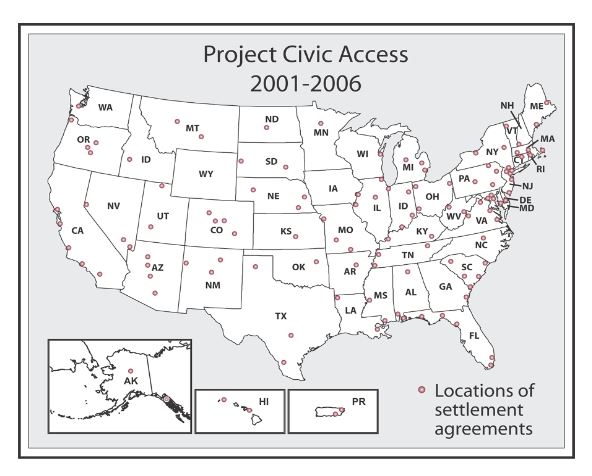
On a Project Civic Access review, Department attorneys, investigators, and architects survey a range of programs and activities, including those conducted in the city and town halls; courthouses; police, fire, and sheriff's departments; centers for health care, childcare, teen, and senior activities; libraries; convention centers; stadiums; emergency shelters; polling places; and parks and recreational facilities. Typical issues addressed during a Project Civic Access compliance review include:
-
whether physical modification of facilities or relocation of services is required to provide accessibility;
-
whether and how inaccessible activities, such as town meetings and county court proceedings, may be relocated to accessible locations upon request;
-
whether there are viable alternate means of making particular services accessible, such as the availability of absentee balloting;
-
whether and how to meet accessibility standards with respect to facilities and sidewalks;
-
whether assistive listening systems are provided in assembly areas (e.g., legislative chambers, courtrooms, and municipal auditoriums);
-
whether 9-1-1 emergency response services are accessible to citizens with hearing or speech disabilities;
-
whether telephone communications in other governmental functions are accessible;
-
whether government websites are usable by citizens with vision impairments;
-
whether the community provides adequate procedures and time frames for citizens requesting and securing auxiliary aids, such as sign language interpreters, when needed for effective communication;
-
whether there is permanent and conspicuous notice to the members of the community of their ADA rights and the local government's ADA obligations; and
-
whether government offices employing more than 50 persons provide an ADA grievance procedure.
The Department has published two guides specifically designed to assist local officials, which are available on its www.ada.gov website. These booklets, entitled "The ADA Guide for Small Towns"2 and "The ADA and City Governments: Common Problems,"3 review the ADA's requirements and offer practical ways of meeting those requirements in cities and small towns.
Project Civic Access is much more than an inspection program. In fact, the inspection is just the beginning of a truly cooperative venture among the Department, the local jurisdiction, and its citizens. Local government officials have responded favorably and cooperated fully in the Department's reviews. They have provided requested records and documents in a timely fashion, have made themselves available to answer questions during on-site visits, and have escorted investigators throughout their communities in order to assist in the quick and efficient completion of facilities surveys. Sometimes these site reviews result in on-the-spot changes to improve access. Most important, these officials have indicated a willingness to undertake changes in order to make their programs and services accessible to persons with disabilities.
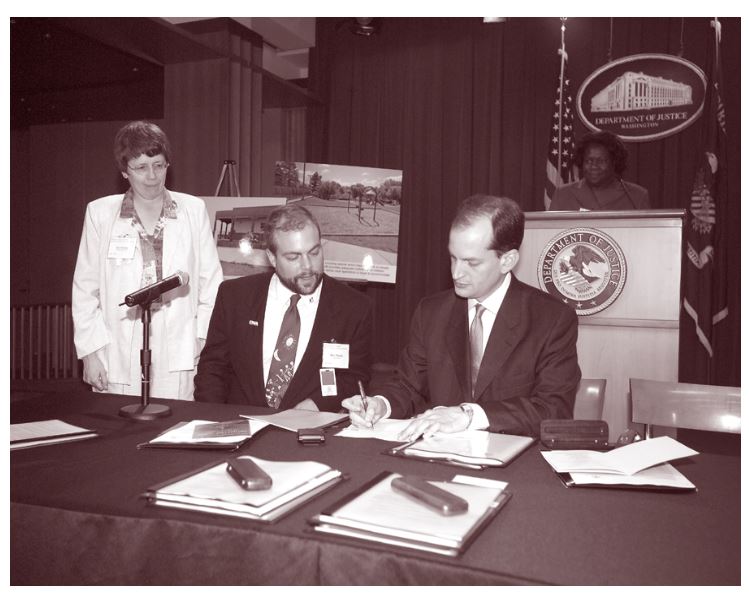
Former Assistant Attorney General R. Alexander Acosta signing PCA Agreement Between DOJ and Juneau, Alaska, at August 2004 DOJ ceremony with Deputy Assistant Attorney General Loretta King, and Building Inspector Sara Boesser and Assemblyman Marc Wheeler of Juneau, Alaska, looking on.
Local officials like Sara Boesser, a building inspector in Juneau, Alaska, usually accompany the Department's staff on their reviews. "It was a wonderful experience to go around watching someone else do all those measurements, but also just to be able to learn from the experts from the Department of Justice and learn some of the things we didn't know," said Ms. Boesser. "The most unexpected pleasure from all of it is the help that DOJ has given us with plan review questions ever since. The more of that service you can offer building departments around the world, the more they're going to give you good service from their end."4
After conducting a location review, investigators discuss their findings with local officials and draft settlement agreements to resolve any outstanding issues. Through Project Civic Access, the Department has learned that the vast majority of communities are aware of their ADA obligations and are making progress toward meeting those obligations. Local officials in Allen County, Indiana,were pleasantly surprised by their experience with Project Civic Access. When the county commission learned that the Department intended to review the local government's ADA compliance, "I think we were very apprehensive," said Marla Irving, a county commissioner who worked with Department officials on their inspection. "We knew that we had some issues . . . . [B]eing ADA compliant isnot always the easiest endeavor to do." But DOJ officials worked closely with local officials to reach an agreement. "It was just a great learning experience for everyone involved. It was not adversarial," said Brian Dumford, the county's human resources director and ADA coordinator.In fact, county maintenance crews began making changes before the Department finished its investigation.5
The results of Project Civic Access are encouraging. In Davenport, Iowa, for example, Project Civic Access will make a real difference for people like John Sparks, who became disabled in a motorcycle accident. Mr. Sparks has a daughter who loves to dance and sing. Her mother took her to classes at Davenport's Junior Theater because Mr. Sparks could not access the theater in his wheelchair. In a 2004 Project Civic Access settlement agreement,6 the city agreed to remedy several elements at the Junior Theater, including widening the main entrance to make it accessible, fixing the exterior ramp, and adding wheelchair seating in the auditorium. After the agreement is fully implemented, Mr. Sparks will be able to take his daughter to classes and enjoy her performances as well.

"I just want to take this time to thank the city of Davenport, the ADA, Project Civic Access, and the Department of Justice as a whole... With all the
changes the city ... has made or plans to make, I will be able to do more activities with my family."
– John Sparks, resident of Davenport, Iowa, at August 5, 2004, Department of Justice roundtable, Washington, D.C.
On August 5, 2004, citizens from across the nation came to the Justice Department to celebrate the signing of the 100th Project Civic Access settlement agreement. Events included a round table discussion where local government officials, community advocates, and individuals with disabilities from seven communities shared their experiences with Project Civic Access and the positive impact it has had.7
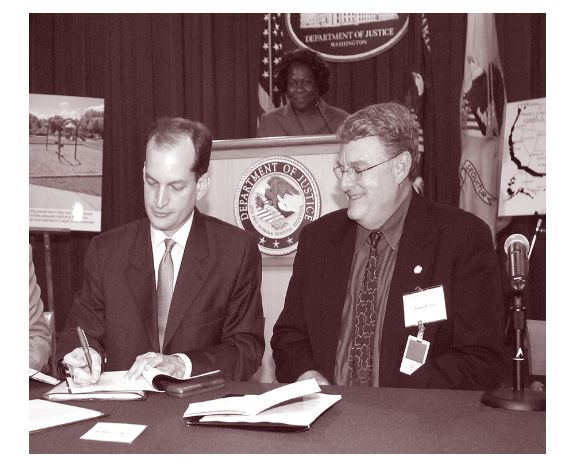
Former Assistant Attorney General R. Alexander Acosta signing PCA Agreement between DOJ and Taos County, New Mexico, at August 2004 DOJ ceremony with Deputy Assistant Attorney General Loretta King and James Dennis, Human Resources Director and ADA Coordinator for Taos County, New Mexico, looking on.
The Department has recently launched the second phase of Project Civic Access, which involves reviewing additional communities in all 50 states and focuses on an expanded range of issues, including accessible curb cuts, voting technology, disaster response planning, domestic violence shelters, and government websites.By increasing the scope of our reviews, the Department will improve access in new communities and ensure that people with disabilities can fully participate in the fundamental aspects of contemporary American life.Their increased participation benefits their entire community and all Americans.
On September 12, 2006, the Attorney General recognized a team of dedicated attorneys in the Disability Rights Section (DRS) of the Justice Department's Civil Rights Division for their accomplishments under Project Civic Access by bestowing upon them the John Marshall Award for Alternative Dispute Resolution. These attorneys—who include both current DRS lawyers and alumni—are:
Elizabeth Bacon
Josh Mendelsohn
Naomi Milton
Mellie Nelson
Beth Esposito
Dov Lutzker
Mary Lou Mobley
Sharon Pietrafesa
Hilary Martinson
Jeanine Worden
-
Equal Access to Public Safety and Emergency Response Services
In light of September 11, 2001 and Hurricane Katrina, the Civil Rights Division has made it a priority to work with localities to ensure that they meet the needs of persons with disabilities during emergencies because they can be among the most vulnerable members of our communities during times of crisis.
Many traditional emergency notification methods are not accessible to or usable by people with disabilities. People who are deaf or hard of hearing cannot hear radio,television, sirens, or other audible alerts. Those who are blind or who have low vision may not be aware of visual cues, such as flashing lights.
In addition, individuals with disabilities often must overcome an array of obstacles in order to evacuate from dangerous areas. A person with a mobility disability may need assistance leaving a building without a working elevator. Individuals who are blind or who have limited vision may no longer be able to independently use traditional orientation and navigation methods. An individual who is deaf may be trapped somewhere unable to communicate with anyone because the only communication device relies on voice. The movement of people during an evacuation is critical, but many people with disabilities cannot use
traditional forms of transportation if they are inaccessible to people with disabilities.
After evacuating dangerous areas, people are often provided safe refuge in temporary shelters. Some may be located in schools, office buildings, tents, or other areas. Historically, great attention has been paid to ensuring that those shelters are well stocked with basic necessities such as food, water, and blankets, but many of these shelters have not been accessible to people with disabilities. Even when individuals using a wheelchair or scooter are able to get to a shelter, they often find the facility lacks an accessible entrance, accessible toilet, or accessible shelter area. Shelter staff and volunteers are often trained in first aid or other areas critical to the delivery of emergency services, but many have little, if any, familiarity with the needs of people with disabilities. In some instances, people with disabilities have been turned away from shelters because of volunteers' lack of confidence regarding the shelters' ability to meet their needs.
Additionally, many shelters have a "no pets" policy, which some mistakenly apply to exclude service animals such as guide dogs for people who are blind, hearing dogs for people who are deaf, or dogs that pull wheelchairs or retrieve dropped objects for persons with mobility impairments. When people with disabilities who use service animals are told that their animals cannot enter the shelter, they are forced to choose between foregoing the safety of the shelter and foregoing the necessary assistance their animals provide in order to enable them to live independently.
Individuals whose disabilities require medications, such as certain types of insulin that require constant refrigeration, may find that many shelters do not provide refrigerators or ice-packed coolers. Individuals who use life support systems and other devices rely on electricity to function and stay alive, but in many cases may not have access to a generator or other source of electricity within a shelter.
People who are deaf or hard of hearing may not have access to audible information routinely made available to people in temporary shelters. Individuals who are blind or who have low vision will not be able to use printed notices, advisories, or other written information disseminated at a shelter.
To address these issues, the Department routinely reviews city and county emergency operations plans as part of our Project Civic Access initiative. To date, the Department has entered into formal agreements with 28 communities to ensure that local governments include the interests of persons with disabilities in their emergency planning activities. Communities including Newark, New Jersey;8 Memphis, Tennessee;9 Arlington10 and Loudoun Counties,11 Virginia; and Maui, Hawaii12 have begun efforts to include the needs of persons with disabilities in their emergency preparations. Communities typically agree to take specific steps,such as:
-
removing architectural barriers to access in emergency shelter parking, pathways, entrances, and toilet and bathing facilities;
-
soliciting input for its emergency operations plan from people with disabilities; ensuring that the community's evacuation plans adequately provide for the evacuation of persons who are deaf or hard of hearing;
-
identifying shelters with back-up generators and refrigeration to provide adequate shelter for persons who use mobility aids and medical devices that require electricity and for those who use prescription medication that requires refrigeration;
-
adopting and implementing policies that prohibit emergency shelter personnel from separating persons with disabilities from their service animals, even if pets are normally prohibited in shelters; and
-
ensuring that there are adequate opportunities for accessible temporary housing for persons with disabilities if such housing is provided to others.
In addition to addressing disaster preparedness for people with disabilities through Project Civic Access, the Department of Justice has worked jointly with the Department of Housing and Urban Development (HUD) to provide technical assistance to the Federal Emergency Management Agency (FEMA) on its transitional housing program. FEMA uses three types of emergency transportable housing to provide transitional homes to people displaced by disasters: travel trailers,one- and two-bedroom recreational vehicles, and three-bedroom manufactured homes. After Hurricanes Katrina, Rita, and Wilma in 2005, the Department dispatched an architect with expertise in disability and accessibility issues to review FEMA's group trailer sites situated near Baton Rouge, to meet with FEMA staff responsible for providing transitional housing to disaster victims in that region, and to inspect the emergency transportable housing being used to house people with mobility disabilities.
The Department's architect met with FEMA officials and contractors to discuss strategies for improving accessible housing options for people with mobility disabilities. Department employees advised the FEMA contractor responsible for constructing group trailer sites about how to build ramps for the units that would house individuals with mobility disabilities. Working jointly with HUD, the Department then prepared guidelines and a model floor plan for an accessible three-bedroom manufactured home, which enabled FEMA to quickly procure accessible units for the disaster area. To ensure that people with mobility disabilities housed at FEMA's group trailer sites would have access to common areas, such as food distribution areas, mail facilities, recreation areas, and laundry facilities, the Department also prepared guidelines FEMA could use to ensure that its group trailer and mobile home sites were designed to be fully accessible. After this initial work was completed, the Department continued to provide technical assistance to officials in Louisiana and Mississippi.
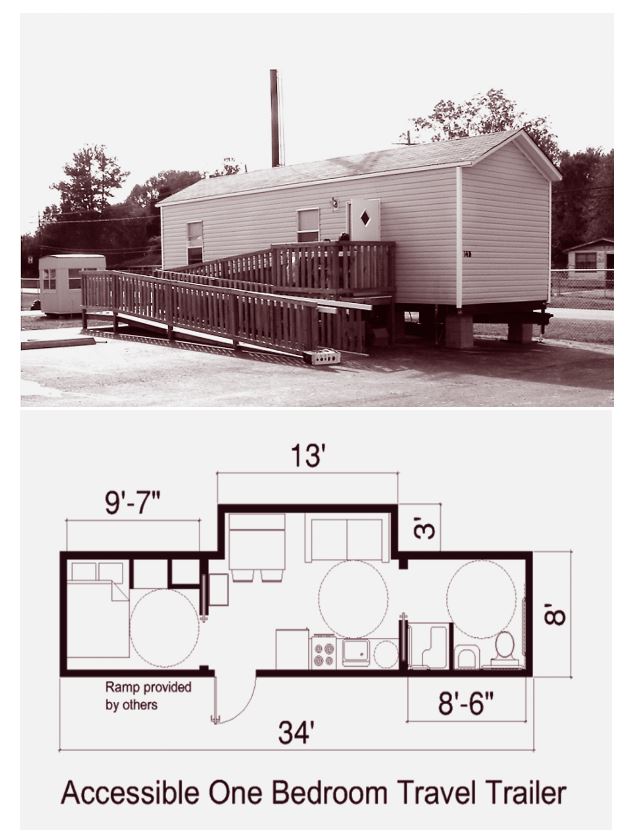
Providing accessible temporary housing ensures that people with disabilities will have safe housing following disasters.
In the spring of 2006, to increase the transitional housing options available for people with mobility disabilities displaced by future disasters, the Department, in conjunction with HUD and the Access Board, developed specifications and sample floor plans for fully accessible travel trailers and accessible one- and two-bedroom recreational vehicles. The Department also provided a one-day training program on disability issues to all of FEMA's equal rights officers who will be deployed to address access issues for people with disabilities following future disasters.
To help ensure that newly constructed and altered facilities in the Gulf area will comply with the accessibility requirements of the Americans with Disabilities Act, Section 504 of the Rehabilitation Act, and the Fair Housing Act, the Department of Justice partnered with HUDt o provide accessibility training for architects, engineers, contractors, and members of the disability communities in Gulfport, Mississippi; Baton Rouge, Louisiana; and Tampa, Florida.The training in Tampa, which also focused on the ADA requirements applicable to emergency shelters and emergency management, was presented in a live webcast available throughout the nation.
The Civil Rights Division recently issued a revised and expanded publication intended to assist local governments in meeting the emergency accessibility needs of individuals with disabilities before emergencies occur. "An ADA Guide for Local Governments: Making Community Emergency Preparedness and Response Programs Accessible to People with Disabilities"13 is intended to help local government planners, first responders, and emergency staff prepare for and meet the unique needs of people with disabilities during natural and civil emergencies. The guide identifies potential problems in notifying, evacuating, transporting, sheltering, and providing information to people with disabilities during emergencies and offers common-sense solutions for preventing or minimizing those problems.
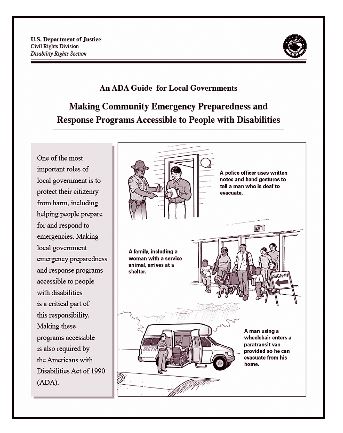
In this publication, the Department recommends a series of proactive steps that local governments should take in order to meet the needs of people with disabilities in emergencies:
-
Solicit and incorporate input from people with different types of disabilities (e.g. mobility, vision, hearing, cognitive, and other disabilities) regarding all phases of the locality's emergency management plan, including preparation, notification, response, and clean up.
-
Ensure that, where sirens or other audible alerts are used as emergency warning systems, there is an alternative method of alerting people who are deaf or hard of hearing of an impending disaster.
-
Adopt policies to ensure that community evacuation plans allow people with disabilities to safely self-evacuate or to be evacuated by others. Some communities are instituting voluntary, confidential registries of persons with disabilities who may need individualized evacuation assistance or notification. Where a locality adopts or maintains such a registry, ensure that procedures are in place to guarantee that it is voluntary and confidential. Also, consider how best to publicize the registry's availability and develop a process to update it on a regular basis.
-
Prepare several alternate forms of emergency communication for use when the electric power supply is affected. These might include the use of telephone calls, auto-dialed TTY messages, text messaging, e-mails, and even direct door-to-door contact with pre-registered individuals.
-
Consider using open-captioning on local TV stations as well as using lower-tech options such as dispatching qualified sign language interpreters to assist in broadcasting emergency information provided to the media.
-
Identify accessible modes of transportation that may be available to help evacuate people with disabilities during an emergency, whether or not a registry is used. For instance, during floods some communities have used lift-equipped school or transit buses to evacuate people who use wheelchairs.
-
Survey the community's shelters for barriers to access for persons with disabilities. For instance, if a locality is considering incorporating a particular high school gymnasium into its sheltering plan, early in the process it should examine its parking, the path to the gymnasium, and the toilets serving the gymnasium to make sure they are accessible to people with disabilities. If barriers to access are found, work with the facility's owner to try to get the barriers removed. If that does not work, consider using another nearby facility for the community's sheltering needs.
-
Invite representatives of group homes and other people with disabilities to meet with the locality as part of its routine shelter planning. Discuss with them which shelters they would be more likely to use in the event of an emergency and what, if any, disability-related concerns they may have while being sheltered. Develop site-specific instructions for volunteers and staff to address these concerns.
-
Until all emergency shelters have accessible parking, exterior routes, entrances, interior routes to the shelter area, and toilet rooms serving the shelter area, identify and widely publicize to the public, including persons with disabilities and the organizations that serve them, the locations of the most accessible emergency shelters.
-
Adopt procedures to ensure that people with disabilities who use service animals are not separated from their service animals when being sheltered during an emergency, even if pets are normally prohibited in shelters. While localities cannot unnecessarily segregate persons who use service animals from others, they may consider the potential presence of persons who, for safety or health reasons, should not be with certain types of animals.
-
Ensure that a reasonable number of emergency shelters have back-up generators and a way to keep medications refrigerated (such as a refrigerator or a cooler with ice). These shelters should be made available on a priority basis to people whose disabilities require access to electricity and refrigeration: for example, for using life-sustaining medical devices, providing power to motorized wheelchairs, and preserving certain medications, such as insulin, that require refrigeration. The public should be routinely notified about the location of these shelters. In addition, if a locality chooses to maintain a confidential registry of individuals needing transportation assistance, this registry could also record those who need particular medications. This will facilitate planning priorities.
-
Adopt procedures to provide accessible communication for people who are deaf or hard of hearing and for people with severe speech disabilities. Train staff on the basic procedures for providing accessible communication, including exchanging notes or posting written announcements. Train staff to read printed information, upon request, to persons who are blind or who have low vision.
-
Identify temporary accessible housing (such as accessible hotel rooms within the community or in nearby communities) that may be used if people with disabilities cannot immediately return home after a disaster. Many times, necessary accessible features such as ramps or electrical systems have been damaged and are not yet repaired by the time evacuees are able to return home.
-
Make sure that contracts for emergency services require providers to follow the steps outlined above. Review the terms of these contracts on a regular basis to ensure that they continue to meet the accessibility needs of people with disabilities. Provide training to contractors so that they understand how best to coordinate their activities with the locality's overall accessibility plan for emergency services.
In addition to natural and civil emergencies, the Department has focused on providing access to emergency care in more localized emergencies. For example, the Department routinely examines 9-1-1 systems to ensure that they are accessible to people who use TTY's. Improvements to 9-1-1 systems are regularly mandated as part of the Department's Project Civic Access agreements.
3. Access To And Fair Treatment In The Legal System
Interacting with law enforcement officials, participating in court proceedings, and being incarcerated are some of the most stressful encounters that citizens can have with government. Imagine how much greater the stress is for people who, simply because of their disabilities, cannot hear what a police officer is saying to them, cannot climb the steps to the courthouse door, or cannot participate in the counseling and rehabilitative services available to other inmates. Judges, attorneys, court staff, and potential jurors with disabilities also face daunting challenges when attempting to fulfill their roles in the legal process.
The Department is working with state and local governments around the country to eliminate these inequities. Through Project Civic Access, the Department has worked closely with numerous counties and towns to ensure that courthouses and courtrooms are accessible. Settlement agreements have required modifications to jury seating and deliberation areas, judges' benches, spectator seating, and routes of travel so that they are accessible to people with mobility disabilities.
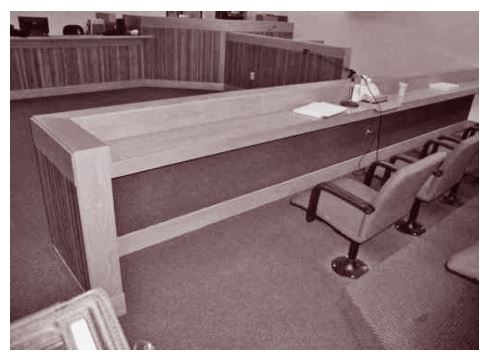
Example of accessible jury box.
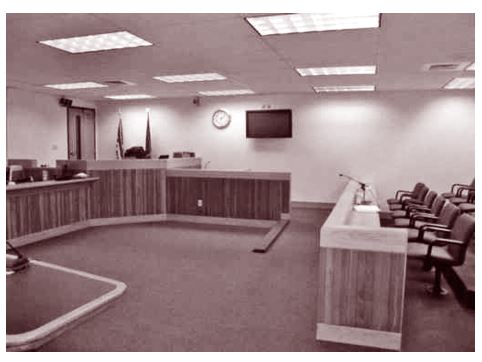
Example of accessible route and ramp to witness stand.
The Department also uses litigation when necessary to ensure access by the disabled to the judicial system. For example, in 2004 the Department brought and settled a lawsuit against the Commonwealth of Massachusetts and Bristol County, Massachusetts, alleging that they failed to make the services, programs, and activities of the county's trial courts and registries of deeds accessible to people with mobility disabilities. The lack of physical accessibility - courtrooms and registry offices were located up flights of stairs in buildings without ramps or elevators - allegedly prevented two lawyers with disabilities who were named as plaintiffs in the lawsuit and other lawyers, parties, witnesses, jurors, spectators, and citizens with disabilities from gaining access to the services of five courthouses and three registries of deeds offices. Massachusetts agreed to make structural changes at each courthouse by constructing an elevator or ramp, along with accessible restrooms. The agreement also called for modifications of procedures to ensure that any services or programs located in inaccessible areas in a courthouse would be provided to lawyers, parties, witnesses, jurors, and spectators in an accessible area. In addition, Bristol County agreed to construct a ramp or elevator and accessible restrooms at its registries of deeds offices to ensure physical access to the registries and their services. Until these structural changes are completed, each registry will serve people with mobility disabilities via mail, internet, facsimile, and curbside service.14
In addition to physical accessibility issues, Project Civic Access agreements have required counties and towns to ensure that people who are deaf or hard of hearing receive appropriate auxiliary aids and services during court proceedings. For example, in November 2003, the State of Connecticut Judicial Branch, Superior Court Operations Division in Hartford, Connecticut, entered into an agreement with the Department resolving a complaint alleging that the state had failed to provide a sign language interpreter for a man who is deaf at three judicial proceedings. Under the agreement, the state will furnish appropriate auxiliary aids and services, including qualified sign language and oral interpreters, where necessary in the future to ensure effective communication with individuals with disabilities.15
The most frequent ADA complaint the Department receives against law enforcement agencies and officers is that they do not provide effective communication with people who are deaf or hard of hearing. For example, a complainant who is deaf alleged that the Phoenix Police Department discriminated against him on the basis of his hearing disability by failing to provide him with a qualified sign language interpreter at the time of his arrest. In an April 2003 agreement, Phoenix agreed to integrate a policy on effective communication into the police department's operations manual. Employees were trained in the requirements of the policy, a notice was published in the local newspaper regarding the new policy, and mandatory ADA training sessions were held for all sworn personnel in order to instruct them to comply with the provisions of the agreement.16
Similarly, the Michigan Department of Human Services entered into an April 2006 agreement resolving two complaints filed by deaf parents who alleged that the state had refused to provide them with interpreters when they were interviewed by case workers during child abuse and neglect investigations involving their children. Michigan agreed to (1) adopt a new effective communication policy; (2) require case workers to indicate on a revised intake form if a parent has a disability and requires an interpreter for effective communication; (3) issue a public notice regarding the ADA's applicability to the agency; (4) update its hotline numbers, its website, and other pertinent literature to include a TTY number and the Michigan relay number;17 and (5) train its 150 managers and 9000 employees annually on the ADA and its requirement to provide interpreters when necessary for effective communication.18
"This disability rights initiative demonstrates the Department's continuing commitment to help state and local governments – including law enforcement – understand and comply with the ADA,"
- Civil Rights Division Assistant Attorney General Wan J. Kim, announcing the Law Enforcement Outreach initiative on May 2, 2006.
To help state and local law enforcement agencies understand their responsibilities under the ADA, on April 28, 2006, the Department finished sending a mailing to 25,000 police departments, sheriff's offices, highway patrols, and other state and local law enforcement agencies throughout the country, offering a variety of free ADA publications and videotapes developed specifically for law enforcement audiences. The mailing included two new compliance assistance publications – a brochure for officers19 and a model policy20 – on how to communicate effectively with people who are deaf or hard of hearing. The agencies also received information on how to order the videotape "Police Response to People with Disabilities." Intended for roll-call training, the video is divided into eight different five- to ten-minute segments that address law enforcement situations involving
people who have mobility, speech, hearing, or vision disabilities, mental illness,
mental retardation, or epilepsy or other seizure disorders. A fully accessible streaming version of the video is also available for viewing on the ADA website (www.ada.gov),21 enabling officers whose vehicles are equipped with internet access to quickly review the relevant segment for guidance when interacting with a person with a disability as a witness, suspect, victim, or person in need of assistance.22
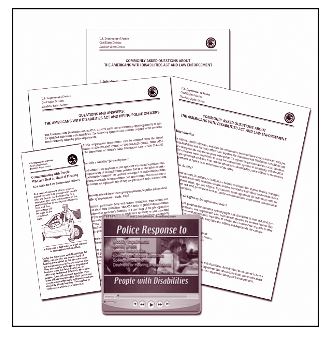
At the end of 2004, nearly seven million people were on probation, in jail or prison, or on parole - 3.2 percent of all U.S. adult residents or 1 in every 31 adults. States held 1,244,311 prisoners in custody and local jails held 713,990. An additional 70,548 persons under jail supervision were serving their sentences in the community.23 This population includes an increasing number of people with a wide variety of disabilities. For example, the Department's Bureau of Justice Statistics reported that at midyear 2000, 16 percent of state prisoners were identified as mentally ill. Of the mentally ill, almost 79 percent received therapy or counseling; about 60 percent received psychotropic medications, including anti-depressants, stimulants, sedatives, tranquilizers or other anti-psychotic drugs.24 There are prisoners with mobility disabilities, including paraplegia and quadriplegia. Others are deaf, hard of hearing, or blind. Still others have medical conditions such as cardiac disease, diabetes, HIV infection, hypertension, and seizure disorders. And, with thousands of prisoners serving long sentences without eligibility for parole, prisoners are aging and the population of the elderly and infirm is growing.
In many ways, correctional facilities face the same obligations and challenges to provide access to people with disabilities as other public facilities. But because prisoners are confined to correctional facilities 24 hours a day, often for years at a time, barriers to access, like an inaccessible toilet or shower, or the failure to provide effective communication to prisoners with hearing or vision impairments, impose especially severe burdens on inmates with disabilities.
In response to these trends and to the increasing number of complaints filed by prisoners, the Civil Rights Division and the Office of Justice Programs (OJP), which provides federal grants and assistance to state and local law enforcement agencies, are collaborating to improve the accessibility of the nation's correctional facilities. Together, they have developed outreach, technical assistance, and investigative strategies to educate correctional officials about their obligations and to highlight effective measures for making programs and facilities accessible to inmates, employees, and visitors. This collaboration, which is known as the Justice Project, has resulted in prompt and meaningful relief that has improved the quality of life for numerous inmates with disabilities by providing, for example:
-
proper shoes for a diabetic inmate,
-
a prosthetic leg for an inmate that allowed him to live in the general population instead of the prison infirmary and to participate more fully in the programs and activities available for prisoners,
-
a sign language interpreter for a deaf inmate so he could participate in educational programs,
-
appropriate housing and treatment for a mentally ill inmate,
-
an electric wheelchair for an inmate with mobility impairments after the prison lost the wheelchair he had when he arrived,
-
repair and return of an inmate's prosthetic hand,
-
appropriate aids and services for an inmate with a hearing disability to participate in programming required for release,
-
consideration of an inmate with a disability for a trusty job on the same terms and conditions as other inmates are considered, and
-
a shower chair for an elderly, frail inmate.
Cameo Hoey, a secretary in the Civil Rights Division's Disability Rights Section, received the Excellence in Administration Support award from the Attorney General on September 12, 2006, for her outstanding administrative work in support of the Justice Project
As part of this joint effort, the Department recently issued its "ADA/Section 504 Design Guide: Accessible Cells in Correctional Facilities," a clear and comprehensive explanation of the accessibility features required in designing new prisons, jails, and holding cells.25 This publication targets the wide range of persons and entities involved in the design of correctional facilities, including law enforcement organizations, wardens and correctional officers, sheriffs, parole and probation officers, architecture firms, construction companies, and plumbing and fixture manufacturers that specialize in the design of justice-related facilities.
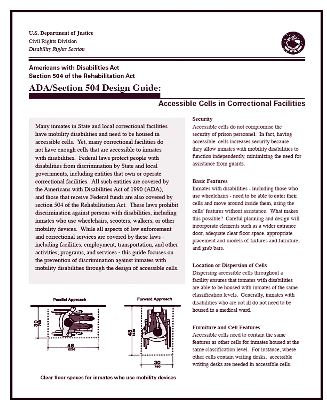
The Department has also investigated and resolved complaints from individual prisoners, obtaining relief that significantly affects the quality of an inmate's life while incarcerated. One of the most widespread complaints is the failure to provide effective communication to inmates with disabilities. This failure often prevents inmates who are deaf or hard of hearing from participating in an array of medical, social, and educational programs offered at a facility. They miss medical appointments, pill calls, and meals because they cannot hear announcements. Blind prisoners and prisoners with low vision complain that they cannot get books on tape or in large print.
In 2004, the Department entered into a settlement agreement resolving a complaint by a Maryland juvenile who was deaf and used American Sign Language. The young man served 18 months in two juvenile detention facilities, where he was required to participate in rehabilitative, educational, and recreational programs. However, because the facilities allegedly failed to provide him with adequate sign language interpreter services, he was usually unable to participate in or benefit from these programs. As a result of the Department's investigation, Youth Services International, a private corporation that operates juvenile justice facilities in eight states, and the State of Maryland Department of Juvenile Services entered into a settlement agreement with the Department.They agreed to provide qualified sign language interpreters or other appropriate auxiliary aids for youths who are deaf or hard of hearing in all of their juvenile facilities and programs, including intake and orientation, medical and psychological evaluations, treatment meetings, educational classes, therapy or group sessions, one-on-one meetings, school or assemblies, group living time, and exit interviews. Maryland will also provide these services for probation meetings and aftercare programs. In addition, each facility will provide visual alarms, hearing aid-compatible and volume-controlled telephones, TTYs, and closed captioning equipment for youth who are deaf or hard of hearing, and will train staff on the requirements of the ADA.26
Inmates in Anne Arundel County, Maryland and Hennepin County, Minnesota will benefit from similar relief as a result of Department investigations. In 2005, Anne Arundel's Department of Detention Facilities entered into a settlement agreement to improve services provided to people who are deaf or hard of hearing at its two detention centers.27 The County agreed to appoint an ADA coordinator at each facility; develop and implement a training program for staff; conduct a hearing assessment of all persons within 24 hours of their admittance; provide qualified sign language interpreters or other auxiliary aids during orientation, disciplinary hearings, reclassification hearings, classification appeals, status reviews, program meetings, meetings with program specialists, and rehabilitative or educational programs; and provide TTYs, closed captioning equipment, and visual alarms at each facility. Hennepin County entered into a similar agreement to resolve a complaint from an adult inmate who is deaf alleging that the county failed to provide an interpreter for chemical dependency treatment and other programs.28
In another case, two inmates who are deaf in the District of Columbia challenged the denial of their request for auxiliary aids necessary for effective communication during their stay in a halfway house. In 2003, the D.C. Department of Corrections agreed to establish policies for providing appropriate auxiliary aids and services, including qualified interpreters, hearing aid batteries, telephones with amplified handsets, closed captioning for televisions, and visual and tactile alarms. The D.C. Department of Corrections also agreed to provide notice to inmates of the availability of these services, to train staff in carrying out the auxiliary aids policy, and to terminate contracts with entities that violate the policy in providing services to inmates.29
Another common complaint is that correctional facilities are not accessible to inmates and visitors with mobility impairments. In 2004, the City of New Hope, Alabama signed an agreement resolving a complaint that neither its jail nor its city hall were accessible.30 The city agreed to book and house prisoners with mobility impairments in accessible facilities in a neighboring county jail. The city also agreed to provide accessible door hardware throughout its facility, a TTY, van-accessible parking, and an accessible drinking fountain.
Similar obstacles to persons with disabilities were alleged to have occurred at the Cheatham County Jail in Tennessee. In 2003, the County Jail signed an agreement requiring it to provide accessible parking, handrails for the entrance ramp, accessible public toilet rooms, an accessible drinking fountain, a designated accessible inmate cell and shower, inmate telephones mounted at an accessible height, and audible emergency warning systems in holding cells or areas. The settlement also requires Cheatham County to provide a text telephone for inmates who are deaf or hard of hearing or who have a speech impairment.31
As the inmate population continues to age, it will be increasingly important that correctional facilities understand and comply with the accessibility requirements of the ADA. Inmates with disabilities will not be able to fully participate in and benefit from the variety of educational, rehabilitational, and substance abuse treatments at the heart of corrections programs unless these institutions and those programs are accessible. Ensuring this access and the potential rehabilitation of inmates with disabilities is vital both for those inmates and for the communities to which they will return when they complete their sentences.
4. Ensuring Nondiscriminatory Zoning and Commercial Leasing Policies
Some of the damaging consequences of disability discrimination are the isolation and segregation of persons with disabilities. In passing the ADA, Congress recognized that such forms of discrimination result in social, vocational, economic, and educational disadvantages to individuals with disabilities, and that such practices run counter to the Nation's goals of assuring equality of opportunity and full participation in society.32 Especially where a disability is based on a mental disorder or mental illness, negative stereotypes and unfounded fears can be formidable obstacles to achieving the type of integration and participation envisioned by the ADA.
One of the ways in which the Department furthers the goal of full participation is through enforcement of the Act's prohibitions against discriminatory zoning and commercial leasing practices.
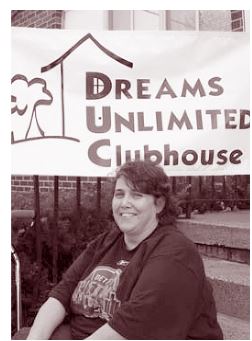
- E-mail from Phyllis Patterson, Member of Dreams Unlimited Clubhouse, July 31, 2006
The Department has resolved several Title II and Title III complaints alleging discriminatory zoning and commercial leasing practices. For example, in 2005 the Department intervened in a lawsuit brought by Easter Seals of Michigan against the City of Royal Oak, Michigan, to challenge the city's denial of a land-use permit for a day program for adults with mental illness. For over fifteen years Easter Seals had operated the Dreams Unlimited Clubhouse in a neighboring town, providing vocational training, skill building, volunteer service programs, and a social network for participants. When Easter Seals sought to relocate to a larger facility in Royal Oak, the organization took what it anticipated would be routine steps to obtain the necessary permits to operate the Clubhouse.However, in a series of public hearings before the city's zoning boards, community members protested against the Clubhouse location. Commenters expressed their belief that the presence of the Clubhouse would lower property values and fear that the neighborhood would no longer be safe for children. And an official on the city's planning commission signed petitions opposing the Clubhouse before chairing a hearing on the permit issue.
The land-use permit was denied, and Easter Seals filed suit, seeking the right to operate the Clubhouse in Royal Oak. After investigation, the Department concluded that the city had discriminated against Easter Seals and its members by impermissibly basing its decision to deny the land-use permit on the fact that the users of the facility would be persons with mental illness. The Department intervened in the lawsuit and worked with the parties to resolve the matter. Under the November 2005 consent decree, Easter Seals was granted the land-use permit to operate the Clubhouse at the desired location and the city paid money damages to the private plaintiffs.33 In addition, city officials participated in mandatory training on the ADA, which was conducted by Civil Rights Division staff.
In another zoning matter, in July 2003 the Department resolved a complaint that the City of Jackson, Mississippi, allegedly refused a zoning change that would have allowed the construction of a mental health crisis intervention center. In public hearings related to the zoning request, members of the public as well as council members allegedly made comments reflecting negative stereotypes about people with mental illness and voiced opposition to the center. Following these meetings, the city council, acting in its capacity as the zoning board, voted to deny the developers' petition. Pursuant to the settlement agreement with the United States, the city held a new vote based on appropriate and lawful criteria, and granted the petition.34 The city paid the developers $40,000 in compensatory damages and provided ADA training to all city council and planning board members on the requirements of the ADA. The city also agreed that in the future it would use appropriate, nondiscriminatory criteria when evaluating zoning petitions involving people with disabilities.
"This was a particularly difficult time for Sinergia...After searching over 50 sites in Manhattan we finally decided on a site only to be leveled with discrimination against our consumers with developmental disabilities. It was a bleak time as winter approached and we struggled to find an affordable alternative...Please accept our profoundest gratitude on behalf of individuals with disabilities and our entire organization. Be assured that this was a unique and wonderful opportunity for our consumers to practice self-empowerment and to witness firsthand justice at work."
- Letter from Myrta Cuadra-Lash, Executive Director, Sinergia, (March 30, 2006)
Discrimination against people with disabilities also occurs in commercial leasing. Under Title III, the Department resolved a complaint filed by Sinergia, a small, nonprofit social service organization that operates a day habilitation program for adults with mental retardation and developmental disabilities. For over twenty years, Sinergia has offered educational, vocational, and social services primarily to low-income, minority communities traditionally underserved by other service providers. When Sinergia sought a new location for its day program in Manhattan, Kaufman Realty Corporation refused to lease to Sinergia because other tenants in the commercial building objected to the fact that Sinergia's clientele would be adults with mental retardation. After investigation of the complaint, the Department notified Kaufman Realty that it was in violation of Title III and the parties agreed to resolve the matter with a consent decree. Under the consent decree, Kaufman Realty agreed to conduct all commercial leasing practices in a nondiscriminatory manner and to pay $175,000 to Sinergia as compensation for monetary damages.35
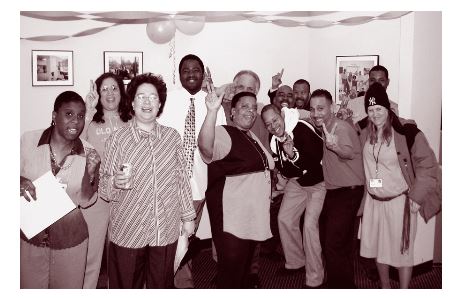
Celebrating the grand reopening of Sinergia.
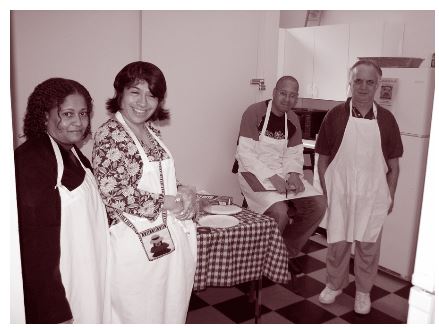
Sinergia consumers prepare to make and deliver breakfast orders
"Prejudice, once let loose, is not easily cabined."
- Justice Thurgood Marshall 36
Prohibiting discrimination in zoning and commercial leasing is at the heart of the ADA. The Department will continue to enforce the ADA vigorously with respect to zoning and commercial leasing practices to ensure that persons with disabilities and organizations providing services to such individuals enjoy the full and equal opportunities protected by the Act.
Footnotes
2 U.S. Dep't of Justice, The ADA Guide for Small Towns, available at http://www.ada.gov/smtown.htm.
3 U.S. Dep't of Justice, The ADA and City Governments: Common Problems,
available at http://www.ada.gov/comprob.htm.
4 Disability Rights Online News, August/September 2004, available at http://www.ada.gov/newsltr0804.htm.
5 County to Boost Disabled Access, Ft. Wayne News Sentinel, June 29, 2005, Page A1.
6 Settlement Agreement between the United States and the City of Davenport, Iowa (Aug. 5, 2004), available at http://www.ada. gov/DavenportSA.htm.
7 More highlights from the roundtable discussion are available on the Department's website at http://www.usdoj.gov/
8 Settlement Agreement between the United States and the City of Newark, N.J. (May 31, 2006).
9 Settlement Agreement between the United States and the City of Memphis, Tenn. (July 25, 2005), available at http://www.ada. gov/memphistnsa.htm.
10 Settlement Agreement between the United States and Arlington County, Va. (Mar. 30, 2006), available at http://www.ada. gov/arlingsa.htm.
11 Settlement Agreement between the United States and Loudon County, Va. (July 25, 2003), available at http://www.ada. gov/loudon.htm.
12 Settlement Agreement between the United States and the County of Maui, Haw. (Sept. 26, 2005), available at http://www.ada. gov/mauisa.htm.crt/ada/newsltr0804.htm.
13 U.S. Dep't of Justice, An ADA Guide for Local Governments: Making Community Emergency Preparedness and Response Programs Accessible to People
with Disabilities, available at http://www.ada.gov/emergencyprepguide.htm.
14 Settlement Agreement between the United States and the Commonwealth of Massachusetts and Bristol County, Massachusetts (Jan. 9, 2004), available at http://www.ada.gov/bristolco.htm.
15 Settlement Agreement between the United States and Connecticut Judicial Branch of Hartford, Conn. (Nov. 3, 2003).
16 Settlement Agreement between the United States and the City of Phoenix Police Dep't, Ariz. (Apr. 7, 2003).
17 The Michigan relay number is part of the telecommunications relay service, a free nationwide service that allows people who use text telephones to communicate with those using telephones. An operator with a TTY terminal receives text from the TTY user and relays that message to the other party, and vice versa.
18 Settlement Agreement between the United States and the Dept. of Human Services, Mich. (Apr. 12, 2006).
19 U.S. Dep't of Justice, Communicating with People who are Deaf or Hard of Hearing, available at http://www.ada.gov/lawenfcomm.htm.
20 U.S. Dep't of Justice, Model Policy for Law Enforcement on Communicating with People Who are Deaf or Hard of Hearing, available at http://www.ada.gov/lawenfmodpolicy.htm.
21 Videotape: Police Response to People with Disabilities (U.S. Dep't of Justice), available at http://www.ada.gov/videogallery.htm.
22 The brochure, model policy, and additional copies of the video can be ordered through the ADA website (www.ada.gov) or the ADA Information Line (800-514-0301 (voice), 800-514-0383 (TTY)), both of which are operated by the Department's Disability Rights Section.
23 U.S. Dep't of Justice, Corrections Statistics: Prisoners in 2004 and Probation and Parole in the United States, 2004, available at http://www.ojp.usdoj.gov/bjs/glance/corr2.htm.
24 U.S. Dep't of Justice, Mental Health Treatment in Prisons, 2000, NCJ 188215 (July 2001), available at http://www.ojp. usdoj.gov/bjs/pub/pdf/mhtsp00.pdf.
25 U.S. Dep't of Justice, ADA/Section 504 Design Guide: Accessible Cells in Correctional Facilities, available at http://www.ada.gov/accessiblecells.htm.
26 Settlement Agreement between the United States and the Md. Dep't of Juvenile Services and Youth Services Intl., Inc. (Mar. 29, 2004), available at http://www.ada.gov/mdjs.htm. In 2006, Youth Services International entered into a second settlement agreement to resolve a suit filed by the Department under Title III of the ADA alleging failure to provide a sign language interpreter to a Maryland juvenile as well as failure to comply with the 2004 agreement. Settlement agreement between the United States and Youth Services Intl., Inc. (D. Md. July 11, 2006), available at http://www.ada.gov/ysi.html.
27 Settlement Agreement between the United States and Anne Arundel County, Md. (Nov. 28, 2005), available at www.ada.gov/ annearundel.html.
28 Settlement Agreement between the United States and Hennepin County, Minn. (Dec. 6, 2005).
29 Settlement Agreement between the United States and the Department of Corrections, D.C. (Mar. 20, 2003).
30 Settlement Agreement between the United States and the City of New Hope, Ala. (Apr. 7, 2004).
31 Settlement Agreement between the United States and Cheatham County Jail, Tenn. (Jan. 22, 2003), available at http://www. ada.gov/cheatham.html.
32 See 42 U.S.C. § 12101.
33 Easter Seals-Michigan and United States v. City of Royal Oak, Michigan, No. 05-60010 (E.D. Mich. Nov. 29, 2005), available at http://www.ada.gov/michigan.htm.
34 Settlement Agreement between the United States and the City of Jackson, Mississippi (July 17, 2003), available at http://www.ada.gov/jackson.htm.
35 United States v. Kaufman Realty Corp., No. 06-2021 (S.D.N.Y. March 15, 2006).
36 City of Cleburne v. Cleburne Living Center, 473 U.S. 432, 464 (1985) (Marshall, J., concurring).
II. ENFORCING THE ADA PART 2
5. Equal Access to Parks and Recreation
A local government's parks and recreation facilities play an important part in the life of a community and its members. Unfortunately, many parks and recreation facilities were built without accessibility in mind. Because of this, individuals with disabilities and their families often cannot participate in programs and activities offered at such places as public parks, baseball and football fields, town pools, and county recreation centers.
Under federal regulations, when parks and recreation facilities are built or altered, they must comply with the ADA Standards for Accessible Design (ADA Standards), which require inclusion of features such as accessible parking spaces, routes, toilet facilities, public telephones, and spectator seating areas.37 For parks and facilities that were built or altered before the ADA Standards took effect, local governments usually must devise ways to make the programs and activities in those parks and facilities accessible to people with disabilities. If a local government decides to modify facilities to provide access to a recreation program or activity and has more than one facility available (such as when several ball fields are provided), only some of the facilities may need to be accessible.
As part of our Project Civic Access initiative, the Department routinely surveys parks and other recreation facilities to ensure that they are accessible to people with disabilities. Investigations have included reviews of parks, community centers, recreation centers, nature centers, skate parks, sports and fitness centers, public golf courses, docks, and other recreation areas. The Department has entered into approximately ninety settlement agreements to resolve issues found at such facilities. These agreements include provisions to make toilet rooms accessible, to provide accessible golf carts, and to make paths of travel to play equipment and sports fields accessible.38
The Department's work with communities across the country demonstrates that improving access to parks and recreation areas is important to the quality of life of people with disabilities and to their families and friends. Access to parks and other recreation areas and programs affects an individual's quality of life no matter where he or she lives, from Florida to Alaska and every community in between. For example, in 2002 the Department worked with the City of San Antonio, Texas, to identify ways in which the historic city's programs and activities could be made more accessible. Under the resulting settlement agreement, San Antonio agreed to make physical alterations to city-owned and operated facilities, buildings, and streets to ensure that individuals with disabilities, residents and visitors alike, could fully participate in the city's numerous recreational offerings.
This positive collaboration between the Department and the city has made a difference in the quality of life for everyone in San Antonio. Residents and visitors who use wheelchairs now can enjoy the city's famed Tea Pagoda in Brackenridge Park because the city installed appropriate ramps. Performances at the park's Sunken Gardens Theater can be enjoyed by all because the city constructed wheelchair-accessible seating locations throughout the theater. And families can plan gatherings at a community park with the comfort of knowing that the park's parking, picnic grounds, restrooms, and swimming pools are accessible to individuals with disabilities.
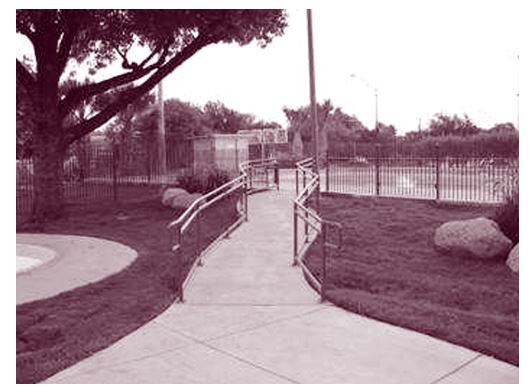
Accessible route to Elmendorf Park swimming pool, San Antonio, Texas.
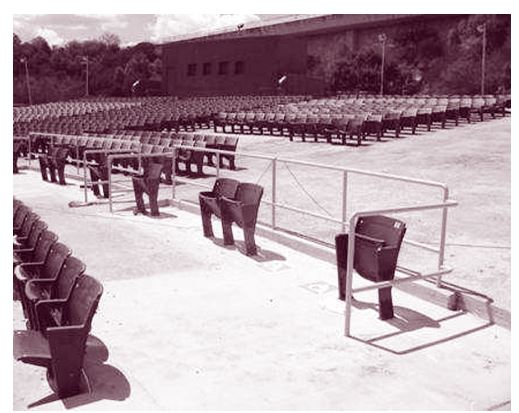
Wheelchair accessible and companion seating at the Brackenridge Park Sunken Gardens Theater, San Antonio, Texas
In July 2002, at a ceremony commemorating the twelfth anniversary of the ADA, the Department publicly recognized San Antonio's positive, ongoing approach to increasing access for all its citizens and visitors.39 Residents, too, have expressed excitement about the city's commitment to full participation for all. Donna McBee, who is blind, remarked on the stark difference the city's commitment has made in her life as a resident of San Antonio: "I first moved to the city in 1981 and would navigate the city streets with a cane. . . . I wasn't always certain of my safety when crossing the street. Since the passage of the ADA, access has improved greatly and mobility is much easier. So much has changed!"40
The City of Springfield, Missouri, was recognized as well at the 2002 ceremony for its efforts in complying with its Project Civic Access settlement agreement.41 Springfield's citizens have also recognized and appreciated the city's efforts to increase access at its many parks, including new accessible paths to playground equipment and picnic tables. For example, Margaret Trimble, a Springfield resident and self-described outdoors person, uses a walker because of a mobility impairment and often found her choices limited to those parks with the fewest obstacles.42 Ms. Trimble told the Department that she is pleased with the changes and added, "The more that parks and natural areas are accessible [the more it] helps families. I really enjoy being able to get down to the banks of a trout stream or being able to attend family and other group outings – wherever they are held."43
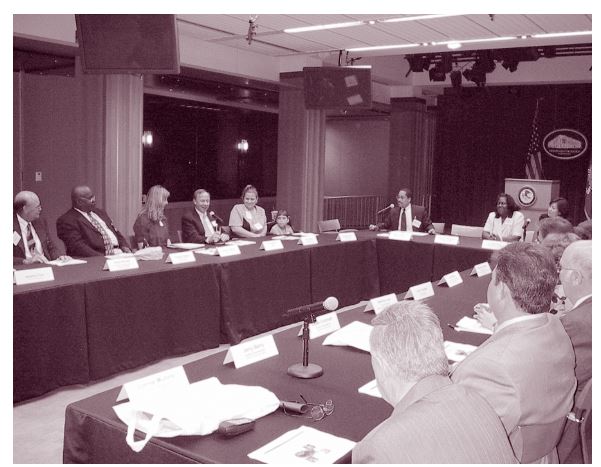
Twelfth Anniversary ADA Ceremony in July 2002 at DOJ with participants including Former Assistant Attorney General Ralph Boyd and Deputy Assistant Attorney General Loretta King
Communities with extreme conditions can encounter unique challenges in furthering the ADA's goal of full participation. For example, in Juneau, Alaska, fishing is a major recreational activity for tourists and citizens alike. Because of Juneau's extreme tides, providing docks at a slope that can be navigated by persons with mobility impairments is a difficult task. But, given the importance of fishing as a community recreational activity, Juneau was determined to build accessible fishing docks. Officials used state and federal money to build two accessible fishing piers, one in freshwater and one in saltwater. One dock is reinforced so that persons with mobility impairments can drive their vehicles out onto the dock, where a lift-off lip assists them as they transfer onto boats. In 2004, the Department reached a settlement agreement with Juneau, according to which the city also agreed to improve accessibility at several harbors, parks, and gyms, as well as at an ice arena, shipping dock, pool, museum, youth center, and visitor's center.44

Accessible Fishing platform in Juneau, Alaska.
San Antonio, Springfield, and Juneau are just three examples of the many local governments that have already significantly improved access to parks and recreation programs as a result of Project Civic Access. Virtually all of the Project Civic Access agreements the Department has reached in the past five years have required cities and counties to begin work to make recreation facilities and programs more accessible to people with disabilities. For example, in 2005 the Department signed an agreement with Florence County, South Carolina, requiring the county to, among other things, improve access to five parks and its civic center.45 And this year, the Department reached a settlement agreement with Arlington County, Virginia, which requires Arlington to improve accessibility at eleven parks, four community centers, two recreation centers, a nature center, a skate park, and a sports and fitness center.46
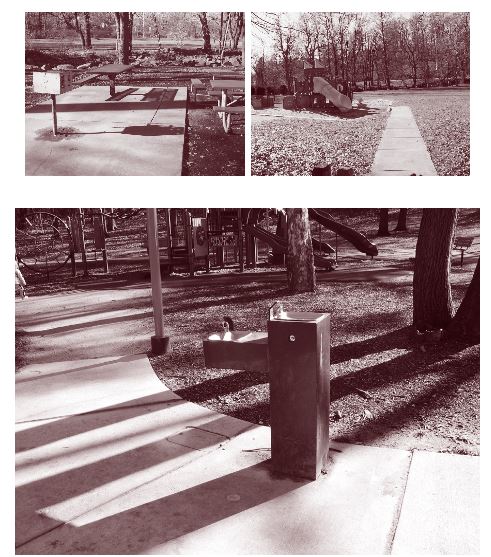
Accessible picnic table, route to playground equipment, and drinking fountain in Arlington County, Virginia.
Whether the fix is simple, such as extending a picnic table to allow an individual who uses a wheelchair to use it, or more complex, like providing access to docks in communities with tides, these solutions are essential to ensure that people with disabilities have the same opportunities as others to enjoy recreational facilities with their family members, friends, and colleagues. Equal access to parks and recreation is a mandate of the Americans with Disabilities Act. The Department will continue to make the enforcement of this mandate a priority along with enforcing equal access in other aspects of everyday civic life.
B. Ensuring Equal Health Care Access
Titles II and III of the ADA cover doctors, dentists, and other health care providers, as well as all hospital programs and services, including emergency room care, inpatient and outpatient services, surgery, clinic services, educational classes, and cafeteria and gift shop services.
Despite the ADA's mandate of equal treatment and accessibility, people with disabilities experience discrimination in a variety of manners in health care settings. For example, in 2001 the Department began an investigation of the Staten Island University Hospital in response to complaints filed with the Department alleging a range of accessibility problems: a separate entrance and separate waiting room for patients with developmental disabilities at its dental clinic, lack of accessible parking and accessible restrooms at its dental clinic, and lack of accessible equipment at its gynecological clinic. The Department negotiated a settlement agreement in 2003 requiring the hospital to resolve these problems and, in addition, to provide auxiliary aids and services for effective communication with people who are deaf or hard of hearing, to make reasonable modifications in policies and procedures as necessary to avoid discriminating against people with disabilities, to provide ADA training to staff, to notify the public of the hospital's obligations under the ADA, and to pay $8000 in civil penalties.47
The three most prevalent accessibility issues in health care settings are lack of effective communication, lack of accessible equipment and services, and refusal of care.
1. Effective Communication
Wherever patients with hearing disabilities interact with hospital staff, a hospital is obligated under the ADA to provide effective communication. The Department's agreements and consent decrees match the methods of communication and services or aids needed to effectuate communication with the abilities of the person who is deaf or hard of hearing and the nature of the communications that are required. For example, exchanging written notes or pointing to items for purchase will likely be effective communication for brief and relatively simple face-to-face conversations, such as a visitor's inquiry about a patient's room number or a purchase in the gift shop or cafeteria. Written forms or information sheets may provide effective communication in situations where there is little call for interactive communication, such as providing billing and insurance information or filling out admission forms and medical history inquiries.
However, in the past few years the Department has focused on ensuring that, for more complicated and interactive communications, health care personnel are aware that it may be necessary to provide a qualified sign language interpreter. Examples of such communications include discussion of symptoms between a patient and medical personnel; presentation by a physician of diagnosis and treatment options to patients or family members; communication with a patient during treatment, testing procedures, or rounds; group therapy sessions; or delivery of educational presentations.
In addition, under some circumstances, the Department's agreements and decrees have provided for an interpreter or other aid for a patient's family members who are deaf or hard of hearing. In United States v. Parkway Hospital, Inc., the Department filed a lawsuit in 2003 against Parkway Hospital, a private hospital in Queens, New York, because the hospital allegedly failed to provide a qualified sign language interpreter for Sarah Posner, an elderly deaf patient, or her husband, who is also deaf, during Mrs. Posner's extended hospitalization at Parkway. In addition, the Department alleged the hospital violated the ADA by imposing communication responsibilities on the Posners' grown children, who were expected to act as conduits for information between the family and hospital staff. Because of these failures, Mr. Posner allegedly was unable to obtain complete information about his wife's medical diagnosis, treatment, and prognosis. Under a consent decree approved by the United States District Court for the Eastern District of New York in 2004, the hospital was required to pay $125,000 in compensatory damages to the family of Mrs. Posner, who was then deceased, and to adopt sign language interpreting policies and procedures intended to ensure effective communication for deaf patients and their family members.48
The Department recognizes that enhanced and emerging technologies may allow health care providers to obtain qualified interpreters more quickly, economically, and efficiently 24 hours a day. For instance, providers may utilize video interpreting services whereby a qualified sign language interpreter appears via video from a remote location on a television-like screen. A health care provider opting for this approach, however, must take the necessary steps to ensure that the appropriate hardware and software are in place to support the system, and that staff understand how to operate and maintain the equipment. This is especially critical in the hospital setting. Where a hospital purports to utilize video interpreting services but does not provide the necessary administrative and operational support to ensure the system works, a patient with a hearing disability is denied his or her right to fully participate in health care decisions, and family members are shut out from communicating with the hospital about their loved one.
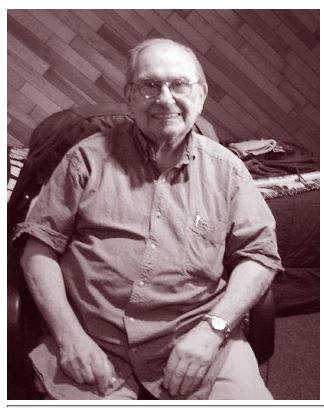
E-mail dated August 7, 2006, from Norman Posner, husband of Sarah Posner
For example, in 2006 the Department intervened in a private lawsuit, Gillespie v. Dimensions Health Corp., d/b/a Laurel Regional Hospital,49 brought by seven deaf individuals against Laurel Regional Hospital alleging a failure to provide appropriate auxiliary aids and services, including qualified interpreters, necessary to ensure effective communication for deaf patients or deaf family members, either in the emergency department or during hospitalizations. In that case, the Maryland hospital had an older system of video interpreting services available, but hospital staff allegedly had difficulty setting up and operating the system. The picture allegedly was, at times, too blurry for a patient to clearly distinguish the arms and hands of the video interpreters, and the video camera allegedly could not be adjusted for prone patients so that the interpreter and the patient could clearly see each other's hands, arms, and heads.
The allegations in the Laurel Hospital case illustrate the problems that can result when a hospital fails to take the necessary steps, through a video interpreting service or otherwise, to ensure effective communication. Hospitals often mistakenly use family members as interpreters in non-emergency situations and inappropriately rely on lip-reading for complicated medical communications – allegations the Department has also encountered in other cases in which it has been involved.50 In Laurel Hospital, the complainants alleged that the hospital failed to provide an interpreter for a deaf patient during hospitalization. The hospital allegedly did not attempt to communicate with the deaf patient in any way, but rather forced her hearing mother to function as a relay person, consecutively exchanging simplistic messages between her adult daughter and the hospital regarding her daughter's condition and treatment. The patient complained to the Department that her mother was often unable to communicate to her what hospital personnel had said, and that because her mother does not know sign language, the patient was forced, often unsuccessfully, to try to read her mother's lips. The patient said she felt frustrated, angry, and ignored by the hospital.
In 2006, the Department resolved the Laurel Hospital case through a comprehensive consent decree,51 which was modeled after several other agreements and decrees executed in the last few years,52 and which included detailed provisions for the implementation and administration of a program to ensure effective communication with persons with hearing disabilities. The consent decree required the hospital to continue to provide both on-site interpreters and interpreters appearing through video interpreting services where necessary for effective communication; to provide other auxiliary aids and services as necessary; to modify medical and intake forms to ensure that once a deaf or hard-of-hearing patient or family member enters the hospital, the hospital makes a communication assessment and, if necessary, a reassessment of the patient or family member; to maintain a complaint resolution/grievance procedure regarding the provision of auxiliary aids and services; and to train hospital personnel to accommodate the communication needs and preferences of deaf or hard-of-hearing patients and family members.
In addition, the Department required Laurel Hospital to satisfy specified performance standards for its video interpreting services regarding the quality and clarity of the televised video and audio, regardless of the body position of the patient, and to train hospital staff to quickly and easily set up and operate the system. The Department also made clear that, except in very limited instances, medical providers should not ask family members or other representatives to interpret for a person who is deaf or hard of hearing because of potential emotional involvement, considerations of confidentiality, and limited interpreting skills.
In United States v. Fairview Health Services,53 the Department entered into a consent decree settling a lawsuit alleging that Fairview Health Services failed to provide qualified sign language interpreters and services to deaf patients. Under the agreement, Fairview agreed to hire and make available one or more qualified sign language interpreters 24 hours a day, seven days a week, to provide effective communication at each of its five hospitals in Minnesota, and to pay $188,000 in damages to four complainants and $20,000 in civil penalties. Fairview will also rewrite its hospital policy and procedures affecting patients with disabilities, develop patient and visitor information and notices in forms that are accessible to deaf and hard-of-hearing patients, and conduct comprehensive training of hospital personnel. Similar agreements have been reached with Greater Southeast Community Hospital in Washington, D.C., St. Francis Healthcare in Wilmington, Delaware, and South Florida Baptist Hospital in Plant City, Florida.54
The Department has resolved complaints about other types of health care providers as well. For example, an eye surgeon doing business in New York City as Advanced Eye Care Associates advertised a free consultation for anyone considering laser vision correction. A man who is deaf called to schedule an appointment and advised the doctor's office that he would need a sign language interpreter at the consultation. He alleged that the doctor's office refused to pay for an interpreter, cancelled the appointment, and told the complainant that he was not a suitable candidate for laser eye surgery because he was deaf. Under the 2005 consent decree in United States v. Saimovici, Advanced Eye Care agreed to follow a policy of nondiscrimination on the basis of disability and to provide appropriate auxiliary aids, including qualified sign language interpreters, free of charge when necessary to ensure effective communication.55 The doctor also agreed to pay $3500 in civil penalties and $1500 in compensatory damages to the complainant.
In another case, a consulting psychologist in Oklahoma City, Oklahoma, who had been court-assigned to consult and evaluate family members involved in a divorce case, allegedly failed to provide an interpreter during an evaluation of a minor child who is deaf. The Department reached an agreement with the psychologist in August 2005 in which he agreed to provide individuals who are deaf or hard of hearing with appropriate auxiliary aids and services, to conduct an individualized assessment to determine which aid or service is needed, and to inform people with disabilities of the availability of auxiliary aids and services.56
A dental clinic in Indiana also entered into an agreement with the Department, resolving a complaint filed by a woman on behalf of her husband who is deaf. The complainant alleged that she requested a sign language interpreter when she called the clinic to schedule a dental appointment for her husband, who needed complex and extensive dental services, but the clinic refused her request. In the April 2006 agreement, the clinic agreed to adopt an effective communication policy and an effective communication assessment form, to post a sign in all of its ten dental offices informing patients that the clinic will provide qualified sign language interpreters when necessary, and to provide mandatory training to all of its employees about the ADA and its new effective communication policy.57
2. Accessible Medical Equipment and Facilities
The use of medical equipment is vital to the provision of medical care. Health care providers use diagnostic equipment to detect serious diseases at an early stage when such diseases are treatable. Unfortunately, the lack of accessible medical equipment and facilities denies health care to many individuals with disabilities. Necessary accessible medical equipment includes examination tables, examination chairs, scales, radiologic equipment (e.g., x-ray and MRI equipment), dental chairs, ophthalmology equipment, and any other equipment used in the medical context that are accessible to and usable by individuals with mobility impairments and other disabilities.
Many individuals with disabilities do not receive adequate medical treatment. For instance, many such individuals receive less comprehensive medical examinations than they should because they are unable to transfer to the proper examining table or chair or to use inaccessible equipment.
The increasing significance of diagnostic testing further underscores the importance of full and equal access to health care services for individuals with disabilities. Cervical and breast cancer rates have been reduced, due in large part to the critical role of preventive measures such as mammography and pap smear tests. These tools are essential in early disease detection, which often is the key to effective treatment and survival. Failure or refusal to perform such examinations and tests due to disability is discriminatory and can have grave consequences. The Department is committed to ensuring that, as the ADA requires, health care services, medical equipment, and diagnostic tests are accessible to individuals with disabilities.
For example, in 2005 Exodus Women's Center, which provides obstetrics and gynecology services to women in four different locations in Florida, entered into a settlement agreement with the Department.58 The agreement stems from a complaint filed by a woman who uses a wheelchair due to a neurological condition. The complainant alleged that, when she arrived for her appointment, Center staff told her that she needed to bring someone to assist her onto the examination table and refused to help her transfer. She left without receiving an important medical examination.
Under the terms of the agreement with the Department, Exodus Women's Center agreed to:
-
purchase an adjustable-height examination table for one office within two months of the agreement and a second table for another office within twelve months;
-
ask patients, when scheduling an appointment, if they will need any assistance, modification of policy, or auxiliary aid or service during the exam due to a disability; and
-
conduct ADA training for all of its medical and administrative staff, including teaching transferring techniques and providing sensitivity training on interacting with individuals with disabilities.
Another alleged failure to provide obstetrics and gynecology treatment involved the Obstetrics and Gynecology Clinic at Georgetown University Medical Center. In 2001, the Department and Georgetown entered into a settlement agreement after the Department received a complaint by a woman who alleged that Georgetown had failed to assist her with transferring from her wheelchair to an examination table when the sole adjustable table was not working.59 Georgetown agreed to pay a civil penalty of $10,000 and damages of $15,000 to the complainant.
When visiting doctors' offices, individuals with disabilities often face major obstacles due to simple things that people without disabilities would not even notice. For example, individuals with mobility impairments may not be able to get into examining rooms due to narrow doors, or they may not be able to maneuver within a room once they gain access. In addition, examination tables and chairs present some of the biggest obstacles for individuals who use wheelchairs or other mobility aids; transfer to an examining table or chair can be impossible without an adjustable table or mechanical lift. The Department's settlement agreement in 2005 with Dr. Robila Ashfaq, a solo practitioner in family medicine in Irvine, California, followed a complaint from a woman with paraplegia who used a wheelchair. She alleged that her husband assisted her onto the examining table during her first visit and that subsequent examinations were conducted in her wheelchair. The complainant further alleged that after she requested that the doctor borrow or purchase an adjustable examination table or lift to facilitate her transfer, Dr. Ashfaq stated that she could not provide an accessible table or lift due to budget constraints and discontinued treating the complainant as a patient.
"When I asked my physician to purchase an accessible exam table, or make some other kind of accommodation, she refused . . . I knew my rights and knew the ADA law backed up my request, so I contacted the Department of Justice and asked for help. They were very understanding, and the claim process was much simpler than I ever thought it would be. When the case was settled and my doctor purchased the accessible exam table, I felt like I had done something really important for others who had mobility issues, especially for women, because there are so few doctors that have them. It feels good to know that I not only helped myself, but helped others, as well."
- E-mail dated August 8, 2006, from Holly Bercik, Orange County, California
Under the terms of the agreement with the Department, Dr. Ashfaq agreed to:
-
purchase an accessible, adjustable-height exam table;
-
adopt a nondiscrimination policy;
-
attend training with her staff about ADA requirements; and
-
ask patients, when scheduling appointments, if they will need any assistance, modification of policy, or auxiliary aid or service during the exam due to a disability.60
In some cases, mammography equipment is literally out of reach of women who are unable to stand, and, in addition, many medical offices and hospitals do not have scales designed to weigh a patient while sitting in his or her wheelchair. Lastly, some facilities lack simple ancillary equipment (e.g., stabilizing elements on examination tables to prevent falling or leg supports for gynecological examinations) that would make otherwise inaccessible medical equipment fully accessible.
As part of its commitment to ensure fully accessible medical treatment for persons with disabilities, the Department entered into two of its most comprehensive settlement agreements under the ADA with Washington Hospital Center and Valley Radiologists Medical Group in November 2005.
Under the terms of the agreement, Washington Hospital Center agreed to:
-
create a minimum of 35 fully accessible patient rooms, with each including an accessible toilet room and an accessible shower (or access to one);
-
purchase adjustable-height beds for all of its accessible inpatient rooms;
-
ensure that each department has at least one accessible examination table that lowers to 17-19 inches from the floor to enable individuals
-
who use wheelchairs to transfer to the examination equipment;
-
survey all of the equipment in the hospital and purchase new accessible equipment needed to ensure that individuals with disabilities receive equal access to medical services, including an accessible examination table or chair in each hospital department that utilizes them;
-
implement a barrier removal plan; and
-
update hospital policies and train staff to address the needs of individuals with disabilities.61
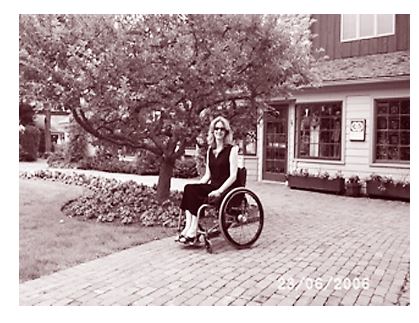
- E-mail dated August 8, 2006, from Rosemary Ciotti, R.N., M.S.N.
The Department's agreement with Valley Radiologists Medical Group arose out of a complaint involving a woman who visited a radiologist's office for a full-body bone density x-ray. Because the woman uses a wheelchair, she allegedly was unable to transfer herself to an examination table without a mechanical lift, which the clinic did not have. As a result, the x-ray could not be performed.
Under the terms of the agreement with the Department, Valley Radiologists Medical Group agreed to:
-
purchase four mechanical lifts and eight transfer boards;
-
ask patients, when scheduling an appointment, if they will need any assistance or service during the exam due to a disability;
-
provide appropriate assistance and equipment at an appointment when requested; and
-
train all medical and administrative staff about the requirements of the ADA, the operation of the transfer equipment, and techniques for assisting individuals with mobility impairments with transferring to the exam table.62
3. Refusal of Care
Having access to health care is a fundamental part of American life. For some individuals with HIV, that access is compromised by health care professionals who refuse to treat those with HIV. The Department recognizes the importance of full access to health care, and has moved aggressively to investigate and resolve such complaints. The Department has carefully studied the medical evidence about HIV and heeded the guidelines issued by the Centers for Disease Control governing safe treatment.63 The Department is also guided by the Supreme Court's decision in Bragdon v. Abbott,64 a case involving a dentist who refused to provide even the most routine dental care to a patient with HIV. The Court held that a medical provider may not refuse to treat by invoking the "direct threat" defense unless the risk of HIV transmission is "significant" and based on objective evidence.65
In 2003, the Department resolved allegations in a complaint filed by a young man who went to the Burleson St. Joseph Health Center in Burton, Texas, for treatment of sinusitis. In the course of providing his medical history, he disclosed that he had HIV. Several weeks later, the Health Center sent him a letter by certified mail informing him that he could no longer receive treatment at the clinic "due to [his] medical condition being out of the scope of service of our nurse practitioner," and suggesting that he see a physician in a town an hour away. Under the settlement agreement negotiated by the Department, Burleson St. Joseph agreed that it would no longer turn away patients with HIV whom it is otherwise qualified to treat, and employees would be trained about the nondiscrimination requirements of the ADA.66
Mark Bourdon alleged a similar experience when his doctor informed him that he would not treat him because of Mr. Bourdon's HIV. In May 2000, Mr. Bourdon consulted the Arizona Bone & Joint Specialists, Ltd., a sports medicine practice with offices in Phoenix and Scottsdale, about a strained muscle in his shoulder. At his initial visit, Mr. Bourdon disclosed he had HIV. When physical therapy failed to correct the problem, he asked his doctor about surgical options. Mr. Bourdon alleged that his doctor refused to perform surgery because of his HIV. Mr. Bourdon filed a lawsuit against his physician, and the Department intervened in 2003. The case settled prior to trial through a consent decree, in which Arizona Bone & Joint Specialists agreed to pay $120,000 in compensatory damages to Mr. Bourdon and $20,000 in civil penalties.67 The doctors adopted a nondiscrimination policy, and agreed in the future not to deny services to individuals with HIV or other disabilities.
Complaints are not limited to refusals to provide care in an office setting. The Department has also focused on the denial of care in an emergency situation. In 2001, John Gill Smith of Philadelphia called 9-1-1 because he believed he was having a heart attack. Paramedics employed by the City of Philadelphia arrived on the scene and, after being informed of Mr. Smith's HIV status, refused to provide the pre-hospital care that would have been reasonable and appropriate for an individual complaining of chest pains. Mr. Smith alleged that they refused to touch him or assess his condition and refused to give him physical assistance in getting out of his home and into the ambulance. He alleged that on the way to the hospital he was verbally harassed and insulted because of his HIV status. The Department filed suit in 2004 seeking to prevent the City's EMS providers from discriminating against individuals with HIV and seeking an award of compensatory damages for Mr. Smith.68 The parties are in settlement discussions to resolve issues in the case. If settlement fails, the case will be scheduled for trial.
C. Gateways to Job Opportunities for People with Disabilities
1. Employment
"Prejudice, we are beginning to understand, rises not from malice or hostile animus alone. It may result as well from insensitivity caused by simple want of careful, rational reflection or from some instinctive mechanism to guard against people who appear to be different in some respects from ourselves. Quite apart from any historical documentation, knowledge of our own human instincts teaches that persons who find it difficult to perform routine functions by reason of some mental or physical impairment might at first seem unsettling to us, unless we are guided by the better angels of our nature."
– Justice Anthony Kennedy69
As we move through the 21st century, a strong economy, the increasing need to replace large numbers of workers exiting the workforce through retirement, and the ready pool of qualified workers with disabilities present an historic opportunity to fulfill the promise of unlimited employment opportunities for people with disabilities. By the year 2014, 36 million people are expected to leave their jobs and will need to be replaced.70 Fully ten percent of undergraduate students – that is, over 1.5 million individuals – report having one or more disabilities.71 It is more important than ever to ensure that people with disabilities in the workforce, and those seeking to enter it, are not turned aside by discrimination.
Responsibility for eliminating disability-based employment discrimination is shared by the Department of Justice and the Equal Employment Opportunity Commission ("EEOC"). The EEOC is responsible for ensuring nondiscrimination in private sector employment and the Department is responsible for ensuring nondiscrimination in employment by state and local government employers. In United States v. Tennessee, the Department challenged Tennessee's blanket statutory exclusion of all individuals with "apparent mental disorders" from employment as sheriffs, police officers, correctional officers, and youth service officers. The case came to the Department's attention after two 9-1-1 dispatchers employed by Weakley County were suddenly subjected to psychological evaluations in 1997 and subsequently terminated even though they had successfully performed their jobs for several years. Under a 2003 consent decree with the Department, Tennessee agreed to stop enforcing the policies, to ask the legislature to rescind the statutes, and to draft new policies pursuent [sic] to the ADA.72
Some discrimination, as in Tennessee, results from sweeping policies. Other forms are more individualized, such as that faced by a Baltimore City public school teacher. In United States v. Baltimore Public Schools, an elementary school teacher who is blind applied for a teaching position with the Baltimore school system. During her two interviews, she used a cane. She was offered a job. When she mentioned that she would soon be picking up her new service animal, the school principal withdrew the job offer. In its 2001 consent decree with the Department, Baltimore agreed to pay the teacher $55,000 in damages and appointed an ADA coordinator for employment matters to help prevent future discrimination.73
In Missouri, a nurses' aid, whose job duties consisted of bathing, grooming, feeding, and generally caring for elderly patients in a nursing home, disclosed to her employer that she had contracted HIV. She alleged that even though her job did not include any invasive procedures, she was promptly terminated because of her disability. In its 2006 consent decree with the Department, Marion County Nursing Home agreed to pay the assistant $25,000 in damages, and agreed to change its employment policies to conform to the requirements of the ADA.74
After many years of hard work, Ronnie Collins entered the police academy to begin training as a state highway patrol trooper. While attending the rigorous, military-style cadet training academy, he asked for additional food as a reasonable accommodation for his diabetes. When it was denied, his blood sugar allegedly became dangerously low, and, as a result, he became combative and was unable to timely report for training. He was then terminated from the academy, rendering him unable to work as a trooper. In its 2004 consent decree with the Department, the Mississippi Department of Public Safety agreed to pay Mr. Collins $35,000 in damages, adopt and institute a reasonable accommodation policy, and train academy personnel about diabetes.75
"It was important to me to know that because of the ADA, the discrimination I encountered because of my diabetes was unlawful and would not happen to others."
- E-mail dated August 12, 2006, from Ronnie Collins
In each of these cases, qualified individuals were denied employment opportunities in a variety of necessary and important jobs simply because they had, or were perceived as having, a disability. The ADA was designed to address situations such as these. Enforcement of the ADA through education, mediation, and litigation is designed to ensure that employers hire and retain individuals with disabilities, and those that are perceived to be disabled, based on merit alone.
Title I of the Americans with Disabilities Act of 1990 prohibits private employers, state and local governments, employment agencies, and labor unions from discriminating against qualified individuals with disabilities in job application procedures, hiring, firing, advancement, compensation, job training, and other terms, conditions, and privileges of employment. The ADA covers employers with 15 or more employees. The ADA’s nondiscrimination standards also apply to federal sector employees under Section 501 of the Rehabilitation Act, as amended, and its implementing rules.
2. Higher Education
As more students with disabilities acquire high school degrees, an increasing number are seeking the opportunities presented by higher education – at two-year colleges or trade schools, universities, and graduate schools. But many students with disabilities face barriers to full enjoyment of their educational experience. These barriers to education in turn make it much more difficult for people with disabilities to achieve their full potential in the labor market.
For example, a student with a mobility impairment may be limited to courses offered in buildings and classrooms that are accessible. And even where she can enter a classroom building, she may not be able to use the laboratory equipment in a science class, open the door to an English classroom, pull up in her wheelchair to the stations in a computer science class, find seating in a history lecture, or visit her professor's office. She may have to go to another building to use an accessible restroom or water fountain. But the route to that building may be blocked by construction debris or may not have curb cuts that enable her to cross the street. There may be no signs to direct her to an accessible entrance to a facility.
Her classmate who is hard of hearing may not be provided an assistive listening device in an auditorium so that he can understand the instructor's words. If fire alarms or emergency announcements in his residence hall or the library do not include a visual component, he will not be aware of them.
A student with a vision impairment may be lost on campus without the benefit of signs that have Braille or raised lettering, and that designate names of rooms or indicate directions to certain locations. She can be harmed by protruding objects – like temporary or permanent hanging signs or certain water fountains – if they are placed in a location that her cane cannot detect.
The Department has been vigilant in responding to complaints of barriers to education. In one 2002 case, the Department investigated a complaint that a number of buildings and facilities on the campus of Millikin University in Illinois were not accessible to people with mobility impairments. Students with mobility impairments allegedly could not access some of the residential facilities offered by the University and could not go from one level of the student union to another without exiting the building. Under a settlement agreement with the Department, the University made a broad range of its campus activities accessible to people with disabilities.76 It agreed to modify entrances, counters, food service lines, telephones, bathrooms, drinking fountains, dining booths, doors, tables, and picnic areas; to repair sidewalks and curbs in order to create accessible routes between buildings; to install an elevator in the student union; and to provide accessible wheelchair seating locations and assistive listening devices in lecture halls.
In 2005, the Department began an initiative to review a number of private colleges and universities, including proprietary schools, in various parts of the country, even absent a specific complaint. The Department recently announced its first two comprehensive agreements with the University of Chicago and Colorado College,77 with others anticipated soon. Both agreements address a wide array of issues and require the schools to ensure increased access to their campuses for students, faculty, and visitors – in particular those with mobility, hearing, and vision impairments. For example, the colleges will:
-
submit accessibility plans outlining proposals to comply with the agreement to the Department for review after seeking public comment;
-
implement campus-wide emergency evacuation, sheltering, and shelter-in-place plans for individuals with disabilities after public comment and Department review;
-
ensure that three percent of the units (and adjacent toilet rooms) in student living facilities are accessible and dispersed among the facilities, and that a reasonable number of housing facilities have an accessible entrance, first floor common area, and toilet room that is usable by a visitor with a disability;
-
display information on their websites identifying accessible routes through the campuses, accessible parking areas, accessible entrances to buildings, and accessible spaces within buildings;
-
post signs at facility entrances and toilet rooms identifying those that are accessible and, at inaccessible entrances and toilet rooms, directing individuals to the nearest accessible entrance or toilet room;
-
provide assistive listening devices for people with hearing impairments in lecture halls, meeting rooms, auditoria, and other assembly areas;
-
move classes and other activities to fully accessible locations when necessary; and
-
correct violations of the accessibility standards for new construction.
The University of Chicago also agreed to ensure that its transportation services – including its fixed-route campus-wide bus system and its on-call evening and night-time service – satisfy the requirements of the ADA.

The University of Chicago's Old Quad.

The University of Chicago's Palevsky Dormitory.
More and more students, including those with disabilities, are also continuing their education by attending graduate school or postgraduate professional school. But some students with disabilities face discrimination in taking the admissions tests or the classes that prepare students for those tests. In 2002, the Department filed suit against the Law School Admission Council, the agency that administers the Law School Admission Test, based on complaints that the Council had failed to provide reasonable testing accommodations to four persons with disabilities. The individuals had requested extra time to complete the examination because of their physical disability, cerebral palsy. But the Council inappropriately insisted that the applicants undergo testing for learning disabilities, without which they would not be granted extra time. Under the terms of the consent decree resolving the case, the Council agreed to grant the requested testing accommodation to candidates who have been granted the same or comparable accommodation on other standardized admission tests; give considerable weight to the recommendation of the candidate's doctor or other evaluator; not require individuals to undergo diagnostic or functional tests that are unnecessary or not commonly utilized by the medical community; and pay $20,000 in damages.78
In June 2006, the Department filed suit against and reached a consent order with TestMasters, one of the nation's largest providers of preparatory courses for graduate school admissions tests.79 This action was based on a complaint by a deaf individual, who was denied a sign language interpreter for a class preparing for the Law School Admission Test. When he complained to the company that they were violating the ADA, the company canceled his registration and would not allow him to take the class. Under the consent order, TestMasters agreed to provide auxiliary aids to students who need them for its preparatory courses nationwide. TestMasters also agreed to appoint an ADA coordinator, train its staff regarding the company's obligations under the ADA, pay $20,000 in damages to the deaf student, and pay $10,000 in civil penalties.
3. Childcare
"I work 40 hours a week on the southwest side of town. This act alone [refusing to provide care for my child] brought me to tears. Having to make such an important decision, I was left with no other choice than to inform my employer that I could not return back to work until I successfully found adequate child care for my son."
- Complaint received by Disability Rights Section in 2005
The Department of Justice receives a large number of complaints that echo this story. The Department is committed to rooting out discrimination against children with disabilities, in part because of the importance of giving parents of children with disabilities the opportunity to participate in the workforce. Recent Census Bureau data shows that two percent of children under the age of three and 3.6 percent of children between the ages of three and five have some type of disability.80 The U.S. Department of Labor's Bureau of Labor Statistics recently reported that nearly 63 percent of the nation's children under the age of five have mothers in the workforce and require some childcare arrangement.81 Fifty-three percent of school-aged children between the ages of five and fourteen also require some type of weekly childcare arrangement, including access to summer camps and after-school care.82
Childcare providers that meet the definition of public accommodation – essentially those childcare providers that provide services open to the public, but not including childcare operated by religious organizations or entities controlled by religious organizations – regardless of size or number of employees, must comply with Title III of the ADA. Similarly, Title II of the ADA applies to childcare centers run by public entities, including Headstart programs and other state and local programs that provide childcare. The ADA prohibits childcare providers from discriminating against persons with disabilities on the basis of disability. Under federal regulations, childcare providers must allow children and parents with disabilities an equal opportunity to participate in the childcare center's programs and services. Specifically, the ADA and/or its regulations provide that:
-
Covered centers cannot exclude children with disabilities from admission to, or integration within, their programs unless their presence would pose a significant risk to the health or safety of others, would require a fundamental alteration of the program, or would result in an undue burden to the center.
-
Covered centers must provide appropriate auxiliary aids and services needed for effective communication with children or adults with disabilities, unless doing so would constitute an undue burden or would fundamentally alter the program.
-
Covered centers must generally make their facilities accessible to persons with disabilities. Existing facilities are subject to the readily achievable standard for barrier removal, while newly constructed facilities and any altered portions of existing facilities must be fully accessible.
"After around a week, [the childcare provider] finally called me back. She said she had discussed [my child's] case with her supervisor, the school nurse, and the school's attorney and informed me that they would be unable to accept our application. . . . I tried to explain that there's no reason to treat a child with a shunt any differently much less exclude him. Many people with vp shunts lead normal lives – I don't think you guys really understand the situation, what a shunt is and what needs to be done or even what can be done to deal with it. She said she understood, but kids [my son's] age fall all the time so it will be difficult to prevent that. . . I explained again that nobody can prevent kids from falling, we just try to do our best. . . . But I never imagined it could lead to his exclusion and I'm still astounded that [the facility] would discriminate against anyone with this condition. And the horrifying thing is the implication that other schools, clubs, etc. might treat [our child] the same way in the future. Then where can he go? How can he have a normal life?. . . The goal of filing this complaint is. . . to know that our son can't and won't be discriminated against as he goes through life."
- Complaint received by Disability Rights Section in 2005
The ADA is designed to ensure that decisions affecting persons with disabilities are based on the reality of each individual's situation. This is frequently not the case in childcare settings. Some childcare providers wrongly assume that a child's disabilities are too severe for the child to be integrated successfully into the center's childcare program. Federal regulations require a childcare provider to make an individualized assessment about whether it can appropriately meet the particular needs of a child within its program. Providers are often surprised at how simple it is to include children with disabilities in their mainstream programs.
For example, in 2004 the Department settled a complaint against the Rieck Avenue Country Day School, alleging that the privately-owned childcare facility in Millville, New Jersey, had refused to enroll a seven-year-old girl with cerebral palsy and epilepsy in a summer program.83 According to the complaint, the girl's mother called the owner-director of the facility to inquire about openings in its summer program. The daughter had just finished first grade and had been attending public school and daycare since the age of eighteen months. She required no additional assistance with daily care or age-appropriate activities, and no modifications to the center's activities or programs were anticipated, with one exception: staff members would need to be informed that she had occasional petit mal seizures, after which she would be very tired or fall asleep. Under the agreement, the facility agreed to adopt a nondiscrimination policy and to publicize that policy in its handbooks for parents and employees. The facility also agreed to provide training to management and staff about the obligations of childcare providers concerning the rights of individuals with disabilities. Lastly, it agreed to pay the mother, on behalf of her daughter, $4000 in compensatory damages.
Sometimes, problems may be solved by childcare providers simply permitting more flexibility in their rules and policies. For example, in 2003 the Department resolved a matter against a Texas childcare center that allegedly refused to enroll a four-year-old child with Down Syndrome who needed diapering.84 The center had a policy of requiring children over the age of three to be toilet trained. The provider agreed to pay $4000 in damages to the complainants, modify its policy to admit children over three who are not toilet-trained if their need for diapering is due to a disability, and provide ADA training to its employees.
"My two year old son was recently barred from enrolling in a day care center because 'they can't handle another special needs child.'. . . he has a diagnosis on the autism spectrum, widely considered by everyone who has seen him to be mild and very treatable. He does not have autism, and he functions well in a typical day care setting and has since he was three months old. . . . I have carefully reviewed Title III of the ADA. A day care center cannot refuse a child on the basis of disability unless he is a physical danger or admitting him would fundamentally change the nature of the program. Neither are true. . . .I would ask you to let them know that they cannot discriminate against children who are not completely typical. I never expected to have my son discriminated against so early in his life."
- Complaint received by Disability Rights Section in 2005.
All children in childcare settings require a certain amount of daily individualized attention. The Department has received complaints alleging that childcare providers are refusing to extend their services to children with disabilities, claiming that they are unable to adequately serve the children. In many instances, the child with disabilities needs little, if any, modification to the program to successfully participate. For children with more severe impairments, modifications can often be made that do not fundamentally alter the provider's programs.
If a child does, however, need one-on-one attention due to a disability, it is still possible that, in certain circumstances, the child can be integrated into a childcare program with reasonable modifications that do not fundamentally alter the program. For instance, consider a child with Down Syndrome and significant mental retardation who applies for admission to a childcare program but who needs one-on-one care to benefit fully from the childcare program. If a personal assistant will be provided at no cost to the childcare center (usually by the parents or through a government program), the child can likely be integrated with reasonable modifications to allow for the child's one-on-one care within the program. (This is not to suggest that all children with Down Syndrome need one-on-one care or must be accompanied by a personal assistant in order to be successfully integrated into a mainstream childcare program.) It is important to note that the ADA generally does not require centers to hire additional staff or provide constant one-on-one supervision of a particular child with a disability.
The Department also has provided technical assistance to centers to enable the providers to find ways to accommodate children with severe allergies. For example, in 2006, the Department offered technical assistance to a large language immersion summer camp program in the Midwest that had refused to enroll a child with severe food allergies because the provider would not agree to administer epinephrine via an "Epi-pen Junior" in the event of a life-threatening emergency. After receiving technical assistance from the Department, the camp decided to enroll the child and she participated successfully in the camp program.
Similarly, the Department has helped children with diabetes, who can usually be integrated into a program without fundamentally altering it, to participate in various children's programs.
"We are very grateful to the Department of Justice for their interest in Eleanor's case [against TSI] and for their efforts on behalf of her and all diabetic children."
- E-mail dated August 8, 2006 from Quint Medley and Kay Thompson, parents of Eleanor
For example, in 2006 the Department entered into a consent decree with Town Sports International, Inc., and its Wellesley, Massachusetts camp to resolve a lawsuit filed by parents of a child with insulin-dependant diabetes and to ensure equal opportunity for children with diabetes at Town Sports camps and programs.85 The consent decree, filed in the United States District Court in Boston, resolved allegations that Town Sports excluded the elementary school student because of both her diabetes and her use of an insulin pump to control her diabetes in violation of the ADA. The company and its local sport club have agreed to evaluate the application of each child with diabetes who applies to any Town Sports International camp in the United States on a case-by-case basis and to make reasonable modifications to permit children with diabetes to attend its camps. TSI agreed to supervise campers while the campers check their blood glucose levels and use insulin pumps, syringes, or other diabetes-related medical equipment, and to monitor the campers' consumption of food. The consent decree also required Town Sports International to pay $25,000 in damages to the plaintiff and $5000 in civil penalties.
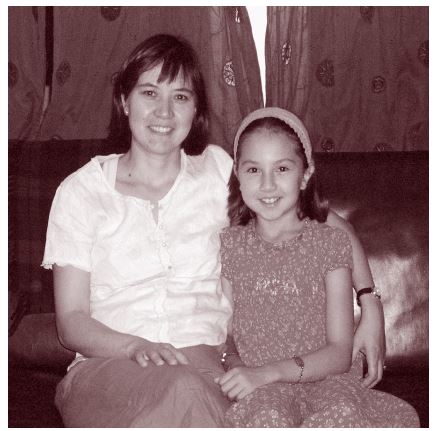
Kay Thompson and daughter Eleanor.
Finally, the Department continues to work to eliminate discrimination against children without disabilities who face discrimination because of the disability status of their parents. The Department reached an agreement with Wee-Kare Nursery, a home-based daycare center in Virginia, resolving a complaint that the childcare provider had terminated a child from its program because his mother had hepatitis C.86 Allegedly, after the child's mother told the daycare owner in confidence that the reason she had been going to so many doctor's appointments was because of her hepatitis C, the nursery owner said that she would no longer take care of her son, even though the child had tested negative for hepatitis C. The owner of the facility also allegedly told the parents of other children in the program of the parent's health issues. The owner agreed to attend a training program on the ADA obligations of childcare providers, adopt a written nondiscrimination policy, and pay $1000 in compensatory damages to the complainant.
D. Enjoying the American Way of Life
1. Entertainment and Leisure
Recreational activities for children and adults, ranging from bowling and water aerobics to softball, baseball, basketball, and soccer leagues, play a critical role in the lives of many Americans. Recreation vastly improves the quality of people's daily lives. Unfortunately, many adults and children with disabilities have been excluded from participating in many games and activities not by choice, but by exclusionary policies that put them on the sidelines.
The ADA addresses this problem by giving people with disabilities an equal opportunity to participate in most recreational activities unless participation by a person with a disability would pose an undue burden or would fundamentally alter the recreational activity. The United States Supreme Court endorsed this concept of equal participation for people with disabilities when it held in PGA Tour, Inc. v. Martin that it was appropriate to reasonably modify a rule banning golf carts when necessary to allow a disabled professional golfer to participate.87
The Department has worked to advance this important goal for people with disabilities. For example, a deaf referee in the Eastern College Athletic Conference (ECAC) alleged that her officiating assignments were reduced and she was excused from the otherwise mandatory referee camp for women's basketball officials because she required a sign language interpreter. The Department entered into a 2003 settlement agreement with the ECAC to provide her with an equal opportunity to officiate at games, to provide appropriate auxiliary aids and services, and to notify its member institutions about the ADA's requirement for effective communication.88

- E-mail dated August 17, 2006, from Justin "Pono" Tokioka, age 11.
The Department and PONY Baseball, Inc. signed a 2006 settlement agreement that will ensure that players who are disabled, including those who are deaf or hard of hearing, have an equal opportunity to participate in PONY's 3500 baseball and softball leagues.89 The agreement stemmed from a complaint from the parents of Justin "Pono" Tokioka, who alleged that their son was denied access to a sign language interpreter during a 2005 PONY baseball tournament. As part of the settlement agreement, PONY agreed to modify its rules to allow players to use sign language interpreters during games, provide sign language interpreters for players who are deaf or hard of hearing, and make reasonable modifications to its rules and practices to allow players with disabilities an equal opportunity to participate.
These examples illustrate how simple modifications in policies or reasonable accommodations can have a profound impact on individuals with disabilities – and can make the difference between enjoyment and exclusion.
During the congressional hearings preceding the passage of the ADA, reports, surveys, and testimony offered by numerous witnesses made plain that many persons with disabilities led isolated lives and did not frequent places of public accommodation. For example, according to one national poll: "The survey results dealing with social life and leisure experiences paint a sobering picture of an isolated and secluded population of individuals with disabilities. The large majority of people with disabilities do not go to movies, do not go to the theater, do not go to see musical performances, and do not go to sports events."90 To address these problems, Title III of the ADA expressly prohibits disability-based discrimination at places of public accommodation and commercial facilities, including movie theaters, sports arenas, concert halls, and outdoor stadiums. Over the last five years, the Department has made great strides toward ensuring that persons with disabilities, along with their families and friends, have equal access to, and full enjoyment of, popular entertainment venues on the same terms as other Americans.
When trying to attend entertainment events at places of public accommodation, people with disabilities frequently face discrimination in ticketing policies and practices. Such problems range from unequal ticketing services to inaccessible ticket counters and the unavailability of accessible seating in stadiums, concert halls, theaters, or sports facilities. Over the last several years, the Department has focused its enforcement efforts on correcting these inequities. For example, in 2002 the Department signed settlement agreements with a number of theaters in Branson, Missouri, which, among other things, required the theaters to provide accessible ticket counters and to implement new ticketing policies so that designated accessible seating is held for customers with disabilities until all other seating has been filled.91
The Department also signed a wide-ranging settlement agreement in 2005 with the world's largest ticketing company – Ticketmaster, Inc. – requiring it to make its ticketing services more accessible to persons with disabilities.92 In this agreement, Ticketmaster agreed to make agents available to sell accessible seating via telephone and e-mail during all hours its system is operational. Ticketmaster also agreed to take appropriate steps to inform customers promptly if its inventory of accessible seating is sold out and whether additional seating might be available directly from the venue. In addition, Ticketmaster will work with venues to implement procedures to reserve the inventory of unsold accessible seats for customers with disabilities until two weeks prior to the event, even if general seating is sold out, and will continue its efforts to develop a system to sell accessible seating directly on its website.
Another hurdle commonly faced by persons with disabilities and their companions when at-tending entertainment events at public facilities is inferior and uncomfortable seating locations. The Department's ADA regulations require public accommodations to provide persons with disabilities choices of admission prices and lines of sight comparable to other members of the audience. All too often, however, persons with disabilities and their companions are offered few – if any – seating choices and instead are relegated to the least desirable seating locations with painful or distorted views of the stage or screen. These problems have proven particularly acute at most of the existing stadium-style movie theaters around the country in which persons with disabilities are often compelled to sit outside the stadium section in the rows closest to the screen. One disabled veteran described his seating location near the front of one stadium-style theater as follows:
"[S]omewhere where before I was in a [wheel]chair I wouldn't even dream of sitting because of the location. A lot of times it's where the parents put their kids, and they sit in better rows. So there's a lot of commotion in that area down front. I have been kicked in the head by a kid flipping over in the seats, all that, so that's why I call it the pit area . . . . You are looking more up. And my chair doesn't recline like your movie chairs. You sit in this position and you can recline somewhat, and my chair doesn't. So I'm . . . watching a movie and always trying to get the full screen effect, and it bothers your neck, my back and sometimes you get headaches . . . . I go out of the theater, out to their lobby area, and my wife helps me. . .stretch around. And then after about five minutes or whatever, we go back in . . . . I would like to be able to – you know, I pay the money, the same price everyone else pays. I would like to be able to be comfortable, sit through the movie with my family or wife and see the movie, you know, the way I used to be able to. Now I am restricted to where they want me to sit. So I have no options.93
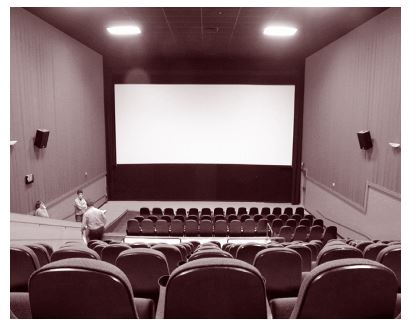
A typical stadium-style movie theater
To address such inequities, the Department has reached nationwide settlements with, or had court orders entered against, the largest theater chains in the country – including the Regal Entertainment Group, Cinemark USA, Inc., National Amusements, Inc., Hoyts Cinemas Corporation, and AMC Entertainment, Inc. Under a consent decree entered in United States v. Cinemark,94 that chain must design new theaters in accordance with Department guidance and approval, placing wheelchair locations in the middle of each auditorium. Cinemark agreed to move wheelchair locations back in over 100 theaters within the jurisdiction of the Sixth Circuit (which covers Tennessee, Kentucky, Ohio, and Michigan) and at theaters in California, Illinois, New York, Utah, and Oregon. The United States negotiated a nationwide consent decree in United States v. Regal Entertainment Group as well, delivering improved sight lines for persons who use wheelchairs across the largest movie theater chain in the country, covering over 3,500 screens.95 Regal agreed to provide improved lines of sight in both existing and new construction movie auditoriums. All future construction will place wheelchair locations in the middle of the seating area, where other patrons choose to sit. A consent order was entered in United States v. National Amusements that provides similar relief at the National Amusements chain.96 Each of these agreements or court orders requires the respective movie theater company to construct ramps to the stadium section in specified auditoriums in their respective stadium-style theaters; to move wheelchair and companion seating farther back from the screen in additional auditoriums; and to correct other ADA violations (such as non-compliant companion seating) as necessary in other auditoriums. These agreements and orders include design standards for stadium-style theaters to be constructed that mirror the Department's proposed regulatory standards set forth in the Department's Advanced Notice of Proposed Rulemaking issued in September 2004.97 Further, in the AMC litigation, the Court ordered AMC to pay civil penalties of $100,000 and compensatory damages to patrons with disabilities who had suffered discrimination.
The Department's enforcement efforts with respect to addressing seating issues in public accommodations has also included other entertainment venues, such as concert halls and opera houses. The Department entered into a Consent Decree in 2005 with the Apollo Theater Foundation, which operates the historic Apollo Theater in Harlem, requiring the theater to install twelve permanent wheelchair seating locations with companion seats in its orchestra section, as well as to correct other barriers to access at the theater.98 In addition, the Department entered a Consent Decree in 2003 with the Shubert Organization, Inc., to make live theater venues in New York City, both on and off Broadway, more accessible. Wheelchair seating was added in sixteen theaters and ticketing practices have been improved so that tickets for wheelchair seating will be held for persons with disabilities until all other seating is sold out. Shubert also paid civil penalties of $50,000. And, in 2004 the Department settled with the City of Des Moines, requiring the city to make the outdoor riverside Simon Estes Amphitheater more accessible to persons with disabilities by installing a lift and ramps to provide access to newly designated wheelchair seating areas and by installing an assistive listening system for persons who are deaf or hard of hearing.99
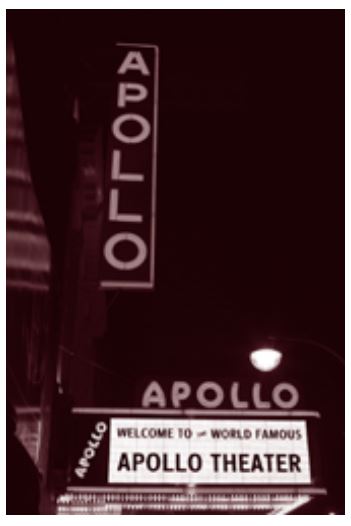
Wheelchair users can now enjoy the historic Apollo Theater in Harlem.
In another agreement, the Washington Opera Company in Washington, D.C., agreed in 2002 to increase the number and locations of accessible seats at its performances held offsite while the Opera House at the John F. Kennedy Center for the Performing Arts was undergoing renovation.100 These new accessible seating locations were dispersed throughout the orchestra section and sold at all of the price categories offered to the general public. In addition, Washington Opera agreed to designate an ADA coordinator, create an ADA advisory committee, and conduct extensive advertising about the availability, pricing, and locations of accessible seating. Structural improvements at the Kennedy Center Opera House also led to more accessible seating at Washington Opera performances. These improvements included increasing the amount of accessible seating dispersed throughout the renovated auditorium. Previously, the only wheelchair-accessible seats in the Kennedy Center Opera House were the most expensive seats.
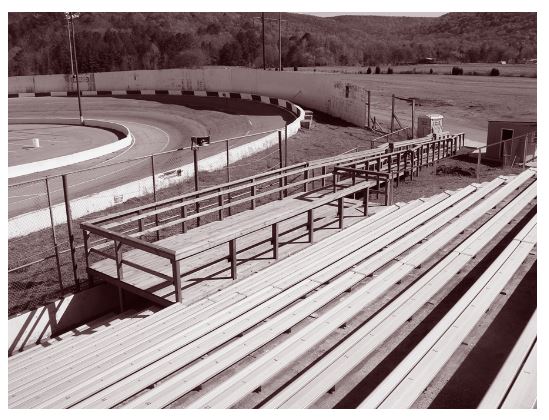
A ramp and accessible seating at the Huntsville Speedway in Huntsville, Alabama
Now, opera fans at these facilities who use wheelchairs truly have an equal opportunity to enjoy performances as they enjoy admission price choices and lines of sight comparable to those afforded the general public.
In addition to seating problems, persons with disabilities frequently encounter inaccessible lobbies, concession counters, restrooms, parking lots, or other architectural features outside the seating areas of places of public accommodations. Settlement agreements and consent decrees over the last five years have also led to significant corrections in such inaccessible features outside the seating areas at a wide variety of establishments – including AMC stadium-style movie theaters nationwide; the Apollo Theater in New York, New York; the White House Theater, Mel Tillis Theater, and Magical Palace in Branson, Missouri; the Huntsville Speedway in Huntsville, Alabama;101 the M&T Bank Stadium (formerly known as PSINet Stadium) in Baltimore, Maryland;102 the West Orange YMCA in Orlando, Florida;103 and the Brookside Gardens near Washington, D.C.104 In the Huntsville Speedway case, for example, the owner has agreed to make physical modifications to ticket counters and toilet rooms for spectators and racers, to improve spectator seating, and to increase accessible routes to the seating.
One final area addressed by the Department concerns the ability of persons with disabilities to safely enjoy entertainment events at places of public accommodation without fear of discriminatory rules restricting access to prescription drugs or other necessary medical supplies.
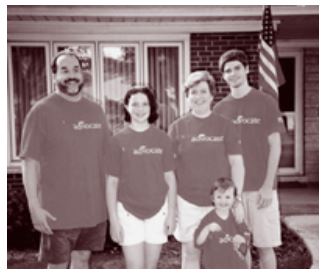
Jim Radermacher and family.
- E-mail dated July 31, 2006, from Jim Radermacher, complainant in United States v. SFX Entertainment, Inc.
In 2003, Clear Channel Entertainment settled with the Department to resolve a lawsuit challenging Clear Channel's policy of prohibiting individuals with diabetes from keeping their medical supplies with them while attending concerts in the 100-plus concert venues owned or operated by Clear Channel throughout the country.105 The policy prohibited patrons from taking any syringes or needles used for medical purposes, including needles used for insulin and lancets for testing blood, into the concert venue unless secured in a first aid room. The policy allegedly violated Title III of the ADA by denying individuals with diabetes an equal opportunity to attend and enjoy concerts since many individuals with diabetes who use insulin must test their blood sugar with lancets and inject insulin with syringes. Lack of immediate access to blood testing equipment, food and/or glucose, and insulin can be life-threatening for such individuals. Under the consent decree, Clear Channel agreed to adopt a new policy that allows individuals with diabetes to keep their medical supplies with them at concerts, to pay damages to the complainants, and to train its employees on its new policy.
"When I was separated from a concert line for carrying my diabetic supplies I was incredibly embarrassed. I felt as if I was being treated like a criminal. My embarrassment quickly turned to anger ... I needed to keep my supplies with me in order to maintain safe controls of my blood sugars. I honestly did not want any other diabetic to experience the humiliation I felt ... the ADA was so quick to respond and so genuinely concerned...I had a renewed strength in keeping my medical needs and health a priority. I will always be grateful to the ADA."
- E-mail dated August 5, 2006, from Mary Jungenberg, complainant in United States v. SFX Entertainment, Inc.

Mary Jungenberg
Footnotes
37 28 C.F.R. pt. 36 app. A (2005).
38 See, e.g., Settlement Agreements entered into by the United States with the following communities: Omaha, Neb. (July 25, 2005), available at http://www.ada.gov/omahanesa.htm; Suffolk, Va. (Sept. 27, 2004), available at http://www.ada.gov/suffolkva.htm; Pueblo, Colo. (June 2, 2004), available at http://www.ada.gov/pueblo.htm; Juneau, Alaska (Aug. 5, 2004), available at http://www.ada.gov/JuneauSA.htm; Gallup, N.M. (Sept. 24, 2004), available at http://www.ada.gov/gallupnm.htm; and San Luis Obispo, Cal. (Dec. 14, 2004), available at http://www.ada.gov/sanluis.htm.
39 Press Release, U.S. Dep't of Justice, Justice Department to Meet with San Antonio Officials as Part of Initiative to Ensure Civic Access for People With Disabilities (July 24, 2002), available at http://www.ada.gov/sanapr.htm.
40 U.S. Dep't of Justice, ADA Stories - San Antonio, Texas, available at http://www.ada.gov/sanastor.htm.
41 Press Release, U.S. Dep't of Justice, Justice Department to Meet with Springfield Officials as Part of Initiative to Ensure Civic Access for People With Disabilities (July 24, 2002), available at http://www.ada.gov/sprstpr.htm.
42 U.S. Dep't of Justice, ADA Stories - Springfield, Missouri, available at http://www.ada.gov/sprstor.htm.
43 Id.
44 Settlement Agreement between the United States and the City of Juneau, Alaska (Aug. 5, 2004), available at http://www.ada.gov/JuneauSA.htm.
45 Settlement Agreement between the United States and Florence County, S.C. (May 5, 2005), available at http://www.ada. gov/florencesc.htm.
46 Settlement Agreement between the United States and Arlington County, Va. (Mar. 30, 2006), available at http://www.ada. gov/arlingsa.htm.
47 Settlement Agreement between the United States and the Staten Island Univ. Hosp. (Aug. 6, 2003).
48 United States v. Parkway Hosp., Inc., No. 03-1565 (E.D.N.Y. Apr. 29, 2004), available at http://www.ada.gov/parkway.htm.
49 Gillespie v. Dimensions Health Corp., d/b/a Laurel Reg. Hosp., No. 05-73 (D. Md.), available at http://www.ada.gov/laurelco.htm.
50 See, e.g., Parkway Hosp., supra n. 48 (allegations included inappropriate reliance on adult hearing daughter for all communications between hospital and deaf patient and spouse).
51 Gillespie and United States v. Dimension Health Corp. d/b/a Laurel Reg. Hosp., No. 05-73 (D. Md. July 12, 2006), available at http://www.ada.gov/laurelco.htm.
52 See, e.g., Parkway Hosp., supra n. 48; Settlement Agreement between the United States and Advocate Ravenswood Hosp. Med. Ctr. (Apr. 3, 2001).
53 United States v. Fairview Health Serv., No. 04-4955 (D. Minn. Dec. 8, 2004), available at http://www.ada.gov/fairview.htm.
54 See Settlement Agreements entered into by the United States with Greater Southeast Cmty. Hosp. (June 22, 2005), available at http://www.ada.gov/secommhosp.htm; St. Francis Healthcare (Nov. 4, 2005); and South Florida Baptist Hosp. (May 5, 2006).
55 United States v. Saimovici, No. 05-7712 (S.D.N.Y. Sept. 1, 2005).
56 Settlement Agreement between the United States and Dr. Ray Hand (Aug. 17, 2005), available at http://www.ada.gov/ rhandsa.htm.
57 Settlement Agreement between the United States and Modern Dental Professional, Indiana, P.C. (Apr. 17, 2006).
58 Settlement Agreement between the United States and Exodus Women's Center (Apr. 26, 2005), available at http://www.ada.gov/exodus.htm.
59 Settlement Agreement between the United States and Georgetown Univ. Hosp. (Oct. 31, 2001), available at http://www.ada.gov/gtownhos.htm.
60 Settlement Agreement between the United States and Dr. Robila Ashfaq (Jan. 12, 2005), available at http://www.ada.gov/drashfaq.htm.
61 Settlement Agreement between the United States and Washington Hosp. Ctr. (Nov. 2, 2005), available at http://www.ada. gov/ whc.htm.
62 Settlement Agreement between the United States and Valley Radiologists Med. Group (Nov. 2, 2005), available at http://www.ada.gov/vri.htm.
63 See, e.g., Centers for Disease Control, Recommendations for Preventing Transmission of Human Immunodeficiency Virus and Hepatitis B During Exposure-Prone Invasive Procedures, Morbidity and Mortality Weekly Report (July 12, 1991), Vol. 40, (RR08), 1-9; Guidelines for Prevention of Transmission of Human Immunodeficiency Virus and Hepatitis B Virus to Health-Care and Public-Safety Workers, Morbidity and Mortality Weekly Report (June 23, 1989), Vol. 38, No. S-6; Recommendations for Prevention of HIV Transmission in Health-Care Settings, Morbidity and Mortality Weekly Report (Aug. 21, 1987), Vol. 36, No. 2S.
64 Bragdon v. Abbott, 524 U.S. 625 (1998).
65 Id. at 649-55.
66 Settlement Agreement between the United States and the Burleson St. Joseph Health Ctr. (Apr. 21, 2003).
67 Bourdon and United States v. Croft, No. 02-1233 (D. Ariz. Feb. 10, 2004), available at http://www.ada.gov/bourdoncons.htm.
68 Smith and United States v. City of Philadelphia, No. 03-6494 (E.D. Pa. 2004).
69 Board of Trustees of the University of Alabama v. Garrett, 531 U.S. 356, 374 (2001) (Kennedy, J., concurring).
70 W. Roy Grizzard, Ed.D., Assistant Sec'y of Labor, Luncheon Keynote Address, Diversity Profit Generation Series: Proving the Financial Business Case for Diversity, New York, New York (June 20, 2006), available at http://www.dol.gov/odep/media/speeches/diversitynyc.htm.
71 Id.
72 United States v. Tennessee, No. 98-1357 (W.D. Tenn. Apr. 15, 2003), available at http://www.ada.gov/tennesse.htm.
73 United States v. Baltimore Pub. Schs., No. 01-4187 (D. Md. Dec. 31, 2001).
74 United States v. Marion County Nursing Home, Inc., No. 05-70 (E.D. Mo. Feb. 2, 2006).
75 United States v. Mississippi Dep't of Pub. Safety, No. 00-377 (S.D. Miss. Mar. 4, 2004), available at http://www.ada.gov/mdps.htm.
76 Settlement Agreement between the United States and Millikin Univ. (Mar. 14, 2002), available at http://www.ada.gov/millikin.htm.
77 Settlement Agreement between the United States and Univ. of Chicago (July 17, 2006), available at http://www.ada.gov/ unichicagosa.htm; and Settlement Agreement between the United States and Colorado Coll. (Aug. 3, 2006).
78 United States v. Law Sch. Admission Council, No. 99-6209 (E.D. Pa. Feb. 26, 2002), available at http://www.ada.gov/lsac.htm.
79 United States v. Robin Singh Educ. Servs. ("TestMasters"), No. 06-3466 (C.D. Cal. June 21, 2006).
80 U.S. Census Bureau, Survey of Income and Program Participation, June-September 2002.
81 U.S. Dep't of Labor, Bureau of Labor Statistics, Women in the Workforce: A Databook, May 2005.
82 U.S. Census Bureau, Who's Minding the Kids? Child Care Arrangements: Winter 2002 (2005).
83 Settlement Agreement between the United States and Rieck Ave. Country Day Sch., (June 2, 2004), available at http://www. ada.gov/rieckave.htm.
84 Settlement Agreement between the United States and Peggy's Child Care, Inc. (July 31, 2003).
85 E.M. v. Town Sports Int'l, Inc., and TSI Wellesley, Inc., No. 05-10611 (D. Mass. Apr. 10, 2006), available at http://www.ada.gov/ tsi.htm.
86 Settlement Agreement between the United States and Joetta Roberts (Nov. 18, 2003). 87 PGA Tour, Inc. v. Martin, 532 U.S. 661 (2001).
88 Settlement Agreement between the United States and the Eastern Coll. Athletic Conference (Oct. 21, 2003).
89 Settlement Agreement between the United States and PONY Baseball, Inc. (Aug. 17, 2006).
90 H.R. Rep. No. 101-485, pt. 2 at 34 (1990) (summarizing 1986 Lewis Harris poll).
91 Settlement Agreement between the United States of America and Mel Tillis Theater (Aug. 1, 2002), available at http://www. ada.gov/meltilth.htm; Settlement Agreement between the United States and Magical Palace (Sept. 30, 2002), available at http://www.ada.gov/magicpal.htm.
92 Settlement Agreement between the United States and Ticketmaster, Inc. (Dec. 22, 2005), available at http://www.ada.gov/ticketmaster.htm.
93 Statement of Uncontroverted Facts and Conclusions of Law in Support of Plaintiff United States' Motion for Partial Summary Judgment Re: Line of Sight Remedies at 14, United States v. AMC Entertainment, Inc., et al., No. 99-1034 (C.D. Cal. Nov. 18, 2002).
94 United States v. Cinemark USA, Inc., No. 99-705 (N.D. Ohio Nov. 5, 2004), available at http://www.ada.gov/cinemark/ cinemark4main.htm.
95 United States v. Hoyts Cinemas Corporation, Regal Entertainment Group, and Regal Cinemas, Inc., No. 00-12567 (Mass. June 8, 2005), available at http://www.ada.gov/regal.htm.
96 United States v. National Amusements, Inc., No. 00-12568 (Mass. Jan. 9, 2006), available at http://www.ada.gov/national.htm.
97 69 Fed. Reg. 58,768 (Sept. 30, 2004).
98 United States v. Apollo Theater Foundation, No. 05-5988 (S.D.N.Y. June 28, 2005), available at http://www.ada.gov/apollomain.htm.
99 Settlement Agreement between the United States and the City of Des Moines, Iowa (Jan. 29. 2004).
100 Settlement Agreement between the United States and the Washington Opera (Sept. 18, 2002), available at http://www.ada. gov/washoper.htm.
101 Settlement Agreement between the United States and Huntsville Speedway (Jan. 19, 2006).
102 Settlement Agreement between the United States and Maryland Stadium Auth. (Dec. 14, 2001), available at http://www .ada.gov/mstadium.htm.
103 Settlement Agreement between the United States and West Orange YMCA (Nov. 21, 2003).
104 Settlement Agreement between the United States and the Maryland Nat'l Capital Parks and Planning Comm'n (Oct. 20, 2003), available at http://www.ada.gov/brooksidegard.htm.
105 United States v. SFX Entertainment, Inc., d/b/a Clear Channel Entertainment (E.D. Pa. June 11, 2003), available at http://www. ada.gov/sfxinc.htm.
II. ENFORCING THE ADA PART 3
2. Lodging
A hotel reservation for an accessible room made a year in advance for travel to a family wedding that is not available on the day of arrival.
A reservation made for a hotel room with a roll-in shower that is non-existent when the guest arrives.
A hotel room without a visual alarm that leaves sleeping guests who are deaf vulnerable to potential emergencies.
A couple with visual disabilities left at the cruise ship gate because they did not bring an attendant.
The Department of Justice routinely receives complaints like these from travelers with disabilities who try to stay in hotels, motels, and other places of lodging, or who try to schedule a cruise.
Long-planned family vacations, cruises, and family reunions, as well as routine business trips, are disrupted or ruined. "No room at the inn" is a reality for many travelers with disabilities, including an ever-increasing number of business travelers with disabilities who regularly face barriers even in newly constructed hotels and motels.
According to a 2005 study by the Harris Poll and Open Doors Organization, a Chicago non-profit organization, four million business travelers and twenty million leisure travelers with disabilities travel regularly. That translates into 70 percent of persons with disabilities in the United States traveling and more than 50 percent of all persons with disabilities in the United States regularly staying in hotels, motels, and places of lodging. When persons with disabilities travel with colleagues, friends, and family members, the potential for lodging dollars spent at small and large businesses expands exponentially.106
Under the ADA, all facilities, including hotels, motels, inns, and other places of lodging designed or constructed after January 26, 1993, must be accessible to and usable by persons with disabilities.107 To meet this requirement, facilities must be built and operated in a manner that complies with regulations published by the Justice Department.108 The regulations contain detailed architectural requirements called the ADA Standards for Accessible Design.109
The ADA Standards for Accessible Design are structured to ensure that facilities are accessible by individuals with a wide variety of different disabilities, such as persons who are blind or have low vision, people who are deaf or hard of hearing, persons with limited use of hands or arms, persons who use wheelchairs, and individuals with a mobility disability who use a cane, crutches, braces, or a walker. Thus, the Standards set minimum architectural requirements to meet the different needs of persons with each of these types of disabilities.
Existing facilities must undertake readily achievable barrier removal, which entails eliminating barriers that can be removed without significant difficulty or expense. The preamble to the Department of Justice ADA Title III regulations explains that ramping two or three steps probably would be readily achievable barrier removal while installing an elevator in place of a stairway in an older building probably would not be readily achievable.110 Similarly, adding grab bars in a toilet room is readily achievable in most cases, while replacing an entire toilet room may not be readily achievable.
The Department of Justice receives a large number of complaints from persons with disabilities about hotels, motels, and places of lodging, and consequently has dedicated considerable time and resources addressing common issues in the lodging industry. For example, in 2005, the Department entered into an agreement with Motel 6 Operating L.P. to resolve violations of the ADA's new construction, alterations, and barrier removal requirements identified in a nationwide review of the hotel chain.111 Under the terms of the agreement, Motel 6 will ensure that more than 600 corporately owned or operated hotels are in compliance with the ADA by December 31, 2006
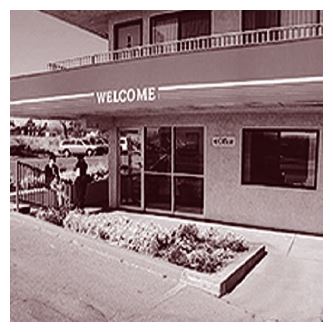
Front entrance of a Motel 6.
Following a 2001 agreement with New York-New York Hotel & Casino in Las Vegas, Nevada,112 the 2023 room hotel will include 32-inch wide accessible bathroom doors in every room so that guests with disabilities may not only use the accessible rooms, but will also have access to bathrooms in rooms and suites where family members or friends are staying. In addition, New York-New York will provide accessible spas, jacuzzis, restaurants, bars, meeting rooms, gaming tables, and slot machines, as well as sign language interpreters, among other improvements.
In 2005, Sports Haven International agreed to complete barrier removal throughout Skyline Mountain Resort in Fairview, Utah, including making at least one of its cabins fully accessible, removing barriers to the clubhouse, including to toilets and shower rooms, and to providing accessible parking at the golf course.113 As a result of a 2004 Settlement Agreement, the Marriott at Metro Center in Washington D.C., recently added roll-in showers in several guest rooms to permit persons who use wheelchairs to shower without transferring onto a tub seat.114 The roll-in showers were required by the ADA but had not been included when the hotel was completely renovated. The Department also recently completed negotiations with the Madonna Inn, a California hotel that provides unique amenities in each guest room; the 2006 agreement calls for barrier removal throughout the historic hotel.115
In 2001, the Department entered into an agreement with Norwegian Cruise Lines to settle allegations that Norwegian was discriminating against guests with vision impairments by requiring them to travel with attendants, provide doctors' notes proving ability to travel, and signing forms assuming liability for on-board injuries during travel, which were not required of sighted guests. As part of the agreement, Norwegian agreed to discontinue such practices and to apply the same requirements to all travelers regardless of disability. The cruise line also agreed to pay a total of $42,000 in damages. Although many cruise lines have argued that they are not covered by the ADA, the Supreme Court recently held in Spector v. Norwegian Cruise Lines116 that cruise lines doing business in U.S. ports are covered by the ADA, at least with regard to certain programs or activities. Although that suit was unrelated to the Department's earlier settlement agreement, the Department filed a "friend of the court" brief in the court of appeals and Supreme Court. The Department is currently reviewing over 200 complaints about cruise lines in light of this recent Supreme Court decision.
The Department often receives complaints from guests with hearing disabilities. The Department recently found that three Ramada Inn hotels had failed to provide "communication kits" to guests with hearing disabilities. Under a series of 2003 agreements with each of the three hotels, the hotels agreed to purchase an appropriate number of kits to assure that guests with hearing impairments would have TTY's, visual door knockers, visual or tactile alarm clocks, and visual signaling devices for their rooms.117 In addition, each hotel will provide TTY's at the desk so that guests may call for assistance with anything from maid service to emergencies and communicate with the hotel management as other guests do routinely. In addition, the Department has reached settlement agreements with other hotels and hotel chains across the country, including Hilton Garden Inn, Super 8, Howard Johnson's, Best Western, Westin, Days Inn, Holiday Inn, and other independent hotels.
The Department also frequently receives complaints from persons with low vision, claiming that hotels have refused to rent rooms to them because of guide dogs. Among others, settlement agreements were completed in 2003 with the Hampton Inn in Taos, New Mexico,118 and the Hilton Garden Inn in Washington D.C.,119 requiring the hotels to permit service animals into the hotel and to enforce policies that allow persons with vision impairments to share in the amenities at those hotels.
3. Transportation
Equal access to public and private transportation is one of the most important rights guaranteed by the ADA because it facilitates the exercise of so many other ADA rights. Working, accessing government services, purchasing groceries – many people with disabilities can only do these things if they have accessible transportation. Accessible transportation also helps integrate people with disabilities into the mainstream of American life. An accessible shopping mall, theater, or park is meaningless for someone who is unable to get there.
The Department has worked to ensure the accessibility of both public and private transportation services and programs. One person who has benefitted from the Department's efforts to make public transportation accessible is Lawrence Dilworth, Jr., a Detroit resident who has spina bifida and uses a wheelchair. Mr. Dilworth encountered so many Detroit buses with inoperable wheelchair lifts that he completely stopped using the city's buses. He and other individuals with disabilities filed a lawsuit against the City of Detroit, alleging that the city used buses with inoperable wheelchair lifts and lacked maintenance and repair programs that would ensure the availability of buses with working lifts. The Department intervened in the litigation to support Mr. Dilworth and the other plaintiffs' right to accessible public transportation.
In 2005, Detroit signed a consent decree under which it agreed to establish systems for promptly identifying, removing from service, and repairing buses with malfunctioning wheelchair lifts, including performing daily maintenance checks and keeping service logs for each bus.120 Detroit also agreed to retrain its drivers and mechanics in the proper way to deploy wheelchair lifts and to assist passengers with disabilities with courtesy and respect. In addition, the city agreed to obtain alternative transportation promptly when there are breakdowns in accessible service, to implement a complaint system to ensure that ADA-related complaints are quickly addressed and resolved, to appoint an ADA coordinator, and to retain an independent auditor to assess compliance with the agreement.
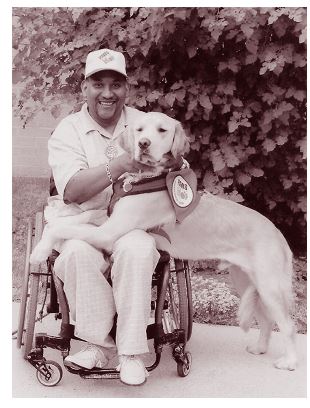
- E-mail dated September 7, 2006, from Lawrence W. Dilworth, Jr. ("Leapin Larry")
Private transportation entities such as taxis and shuttles also provide critical services to people with disabilities. Approximately ten percent of the customer base for taxis consists of people with disabilities.121 Travelers with disabilities also rely on private shuttles to get them to airports and rental cars. The Department has made significant efforts to ensure that taxis and shuttles are accessible to people with disabilities.
One taxi company agreed to make changes after the Department investigated a complaint alleging that one of its drivers refused to help a customer place his wheelchair in the trunk. The company now requires its drivers to provide service to people with disabilities, to assist with the stowing of mobility devices, to transport service animals in the company of individuals with disabilities, to charge the same fares and fees to individuals with disabilities accompanied by service animals or equipment as is charged to others, to post disability rights and complaint notices in taxis, and to maintain a log of all such complaints and resolutions.122 Another company allegedly told people who used wheelchairs that the company's policy did not permit its cab drivers to transport wheelchairs. The Department secured monetary rewards and injunctive relief for these customers.123 Finally, the Department has resolved complaints, without litigation, to ensure that individuals who use a service animal because they are blind, have low vision, or are deaf have equal access to taxi cab services.124
The Department has also helped ensure the accessibility of airport and rental car shuttles. SuperShuttle International, Inc., the nation's largest door-to-door airport shuttle company, agreed in 2002 to provide the same level of service to wheelchair users as it provides to the general public.125 This was the first agreement reached by the Department with a national company that provides transportation on demand as opposed to transportation along a fixed route on a fixed schedule. SuperShuttle agreed to maintain two accessible vehicles at each of its eleven corporate locations nationwide and to subcontract with accessible transportation providers to meet overflow demand. These eleven corporate locations include Phoenix, Arizona; Los Angeles, California; Denver, Colorado; Washington, D.C.; Tampa, Florida; Baltimore, Maryland; New York, New York; and Dallas/Fort Worth, Texas. In addition, Super-Shuttle agreed to train its dispatchers, reservation agents, and drivers about providing equivalent service to its customers on a nondiscriminatory basis. SuperShuttle also paid $4612 in damages to the National Multiple Sclerosis Society.
In addition, ANC Rental Corporation and its subsidiaries, Alamo Rent-A-Car, LLC and National Car Rental System, Inc., have agreed to provide accessible shuttle buses at all airport car rental locations owned by ANC nationwide.126 The settlement agreement resolves several complaints filed by travelers who use wheelchairs or scooters alleging that the companies did not provide accessible shuttle buses between the airport terminal and the rental lots. Under the 2003 agreement, ANC agreed to acquire at least one accessible shuttle bus at each of its locations. ANC also agreed to ensure that all larger shuttle bus vehicles seating 17 or more passengers, as well as up to 10 percent of smaller vehicles they purchase or lease in the future, are accessible. They also agreed to adopt a policy of ensuring equivalent service to individuals with disabilities by providing curbside pick-up and drop-off services when an accessible shuttle bus vehicle is not available.
The Department also entered into a consent decree in 2004 with The Bette Bus Shuttle, Inc., a private provider of fixed route transportation between Memphis, Tennessee, and the airport at Little Rock, Arkansas, and its successor company, Metro Services, Inc. of Moscow, Tennessee.127 The U.S. Attorney for the Western District of Tennessee received a complaint alleging that Bette Bus did not provide wheelchair-accessible vans and that Bette Bus staff refused to allow the complainant to take her wheelchair on its inaccessible vans. As a result, the complainant, who uses a wheelchair for full mobility, was required to travel without her wheelchair, severely limiting her ability to leave her hotel room. The Bette Bus owner acknowledged that the company had purchased at least six 15-passenger vans since 1990, none of which were lift-equipped, and that the company had never provided service to people with disabilities because it thought it was too expensive and would require medical personnel on board. The consent order requires immediate installation of a lift on one vehicle, the equipping of more vehicles with lifts in the future depending on the degree of fixed-route service provided, the elimination of discriminatory policies, the provision of training to employees on how to assist persons with disabilities, and payment of $1000 in damages and $500 in civil penalties.
4. Gas Stations and Convenience Stores
Advances in automobile modifications have enabled a growing number of people with disabilities to drive. People with disabilities also travel frequently as passengers. As both drivers and passengers, people with disabilities must have access to gas pumps and accompanying convenience stores.
Federal regulations require gas stations to provide equal access for their customers with disabilities. In an agreement entered in 2006 by the United States Attorney's Office for the District of Minnesota, Twin Cities Avanti d/b/a Oasis Markets agreed to undertake a significant barrier removal program at its gas station facilities in Minnesota to ensure access for individuals with disabilities.128 In addition, Oasis Markets agreed to train all of its employees to assist customers with disabilities with refueling, consistent with the Department's technical assistance guidance in this area.
"We hope that this settlement will send a message to other businesses about the importance of accessibility to all of their customers . . . . It is great to see the system work for positive change!"
- E-mail dated August 16, 2006, from Diane Winegar, Advocacy/Ramp Program Manager, SMILES Center for Independent Living, Mankato, Minnesota, on the Twin Cities Avanti d/b/a Oasis Markets settlement agreement
The ADA also requires that retail establishments like the convenience stores connected to gas stations comply with the ADA's new construction alterations and barrier removal requirements. Parking areas, entrances, product displays, and other areas available to the store's customers must comply with the ADA.
The Department received a complaint from a woman whose son – a wheelchair user – was allegedly unable to enter a Little General convenience store to use the restroom. The store's entrance and restroom allegedly had barriers to access, the removal of which would have been readily achievable. After an investigation, the Department entered into an agreement in 2003 with Little General Stores, Inc. that required Little General to pay the complainant $3000 in compensatory damages and to improve accessibility throughout the company's chain of 48 gas station/convenience stores.129 Little General represented that 30 out of its 48 retail stores did, in fact, comply with the ADA and agreed to submit documentation and photos of certain elements (such as parking, entrances, toilet rooms, counters, and interior and exterior routes from each store), and to work with the Department to bring these stores into compliance if any further barriers were identified. In addition, Little General agreed to remove barriers to access where readily achievable in the 18 remaining stores that were constructed before the ADA's effective date. It also agreed to make modifications to stores that were altered since the ADA's effective date in order to bring them into compliance with the ADA Standards for Accessible Design.
In a similar agreement with the Department, Sunoco Optima committed to ensuring accessibility at its gas station/convenience stores.130 In 2005, Sunoco Optima agreed to make modifications to its Optima brand gas stations and convenience stores, including by improving accessibility of parking, gasoline pumps, curb ramps, convenience store entrances, and access to items for sale within the convenience stores. Sunoco also agreed to build future stores in compliance with the ADA Standards for Accessible Design.
Similarly, the Department received a complaint alleging that three Florida Chevron stations with convenience stores had failed to remove numerous architectural barriers that prevented or restricted access to the stations by individuals with disabilities, including people who use wheelchairs and people with visual impairments. After investigating the complaint, the Department entered into an agreement in 2006 with Automated Petroleum and Energy Company, Inc., the owner and operator of the gas stations with convenience stores, requiring the company to remove the barriers, including by adding van-accessible parking spaces; reconfiguring entrances; rearranging furniture to provide accessible aisles; and providing accessible restrooms by widening doorways, adjusting the height of lavatories and dispensers, and installing grab bars and accessible hardware.131
5. Dining and Shopping
Restaurants have long served as a key setting for social experiences in America. Whether the reunion location for a milestone family celebration, the intersection point for networking business associates, or the gathering spot for trend-conscious teens, restaurants regularly serve as the backdrop for Americans' interactions with family, friends, and colleagues. Restaurant owners and staff go to great effort and expense to make the dining experience enjoyable, comfortable, and memorable for their patrons and to encourage their return business.
Although most restaurants focus on pleasurable dining experiences for all of their customers, in recent history some establishments have gained notoriety for their discriminatory practices forbidding particular groups entry or service. Today, people with disabilities continue to face barriers to entering and enjoying restaurant experiences. These barriers come in various guises, but they are alike in their ability to bar entrance, embarrass patrons, and even endanger individuals with disabilities.
Lack of accessible parking and steps at entrances, for example, can send the message that people who have mobility impairments are not welcome. That is the message received, for example, by a father who uses a wheelchair when he takes his toddlers out for a long-promised treat and finds that there is no accessible parking in the restaurant lot. Even if he surmounts that barrier, when he arrives at the restaurant entrance he may find that he cannot enter because of two steps at the door.
The Department entered into a settlement agreement with NPC International, Inc. which operates approximately 800 Pizza Hut restaurants in 25 states and is the largest single franchisee of Pizza Hut restaurants in the United States.132 The March 2006 agreement with NPC will ensure accessible parking lots, entrances, seating areas, toilet rooms, self-service counters, and accessible routes through the restaurants. NPC will also build all future facilities in compliance with ADA Standards for Accessible Design, designate a compliance officer, and train all personnel involved in implementing the agreement.
Inaccessible parking and entrances are not the only barriers that keep people with disabilities from entering restaurants. No-pet policies prevent people with disabilities who use service animals from entering. Arguments can erupt over whether the restaurant owner must allow in a service animal, oftentimes in front of other patrons. The would-be patron with a disability frequently leaves embarrassed and unable to enjoy a meal with her family or friends like everyone else.
The Department worked to correct such a situation when it entered into a consent decree in 2003 with Top China Buffet, an Indianapolis restaurant that allegedly violated the ADA when it refused service to a woman who was accompanied by her service dog.133 The complainant, who uses a wheelchair, is assisted by the animal in picking up and delivering objects that she is unable to reach herself. A Top China employee allegedly refused entry to the complainant and her family as they entered the restaurant, even though the dog was wearing a blue harness identifying him as a service animal. The complainant and her husband told the employee that the dog was not a pet, but was her service animal and should be allowed to enter the restaurant. She presented a card certifying that her dog is a specially trained service animal, but the employee repeated that no dogs were allowed. Unable to be seated or served, she and her family left the restaurant. Top China agreed to take corrective steps, including adopting and enforcing a compliance policy about the treatment of customers who use service animals, training its employees, and posting appropriate signs at the restaurant welcoming individuals with disabilities who are accompanied by their service animals. Top China also agreed to pay a total of $5000 in damages to the complainant and her family and $2400 in civil penalties.
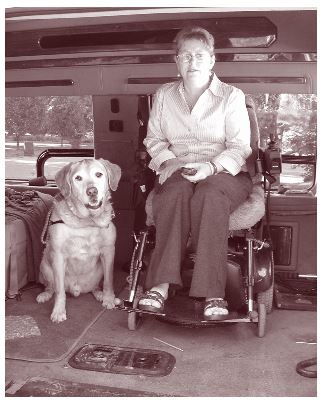
— Betty Barnett, complainant in United States v. Top China Buffet, pictured with Kirk, her service animal.
A recent survey by Open Doors Organization134 showed that almost two-thirds of adults with disabilities encountered obstacles in restaurants – lack of clear routes through the restaurant, inaccessible restrooms, and counters and buffets that are too high to use – making dining out a difficult or impossible experience. While the Open Doors Organization showed that in 2005 more than 50 percent of people with disabilities visited fast-food restaurants once a week, barriers within these popular restaurants continue to exist.135
One effort to remove barriers in a fast-food chain involved the Department's intervention in a lawsuit to enforce the barrier removal requirements of Title III against Valenti Mid-South Management, LLC, a franchisee operating a chain of 54 Wendy's Restaurants in Tennessee, Mississippi, Arkansas, and Missouri. Under the resulting consent decree, Valenti agreed to make a wide range of improvements to each of its restaurants to provide greater accessibility.136 The required barrier removal for each restaurant varies but generally includes providing new curb ramps from parking lots to sidewalks, creating more clear space at entrances to facilitate the opening of doors, reconfiguring customer service lines to allow access to wheelchair users, providing more accessible dining tables, lowering service and condiment counters, widening restroom doors, replacing toilets, adding or remounting grab bars, replacing lavatories, and lowering paper towel dispensers. The order also requires Valenti to pay damages to the private plaintiff in the amount of $25,000.
Although restaurants consider ensuring diners' comfort to be a priority, the connection between the comfort of diners with disabilities and accessible restrooms is too often ignored. Repeatedly, diners with disabilities find either that there are no accessible restrooms at all, that accessible restrooms are unusable because they are constructed improperly, or that accessible restrooms contain boxes and other storage materials making the spaces partially or completely inaccessible. Sometimes the accessible restrooms are so poorly constructed that they can cause injury to the user with a disability.
The safety of patrons with disabilities was the focus of a 2005 consent decree between the Department and 28 Memphis-area McDonald's restaurants owned by Fred Tillman and managed by Century Management.137 The decree ensures that the restaurants will be accessible to individuals with mobility disabilities and individuals who are blind or have low vision. The decree also provides for extensive barrier removal in these restaurants, including by installing a standard accessible stall or accessible unisex restroom in all restaurants, providing accessible routes from parking and public sidewalks, improving signage, lowering self-service counters, placing dispensers within proper wheelchair reach ranges, and removing protruding objects from circulation paths. The consent order also provides for damages in the amount of $40,000 to the complainant, an individual with a mobility disability who was injured when she attempted to use one of the inaccessible restrooms, and a civil penalty of $55,000. In a separate settlement agreement, the McDonald's Corporation guaranteed that it would implement the structural changes required by the consent decree in the event that Tillman or Century Management failed to comply.138
While eating out in restaurants offers a pleasurable social experience associated with food, grocery shopping is one of the basic activities of everyday living, essential to all of us. Yet people with disabilities face barriers even in getting milk and bread. Inaccessible parking, lack of curb ramps, shopping cart corrals that block passage into and out of the store, and aisleways narrowed by merchandise displays all contribute to barring people with mobility impairments from shopping for groceries for themselves and their families.
In an effort to make grocery shopping more accessible to customers with disabilities across the country, the Department in 2004 reached a settlement agreement with Safeway and the Disability Rights Education and Defense Fund, requiring Safeway to correct alleged ADA violations at its over 1500 grocery stores nationwide, including stores owned by Safeway and operated under another name such as Vons, Pavillions, Dominick's Fine Foods, Randall's, Tom Thumb, Genuardi's, or Carr-Gottstein Foods, Co. Safe-way agreed to complete barrier removal and to fix all alleged new construction violations before March 31, 2005.139 It also agreed to hire a full-time compliance officer who will be responsible for ensuring compliance throughout the chain, to provide ADA training to all store managers, and to hire an independent consultant to survey up to 90 Safeway stores (selected by the Department of Justice). Safeway was required to pay up to $200,000 in additional civil penalties as well if the surveys show substantial noncompliance.
"Disabled people ... do a lot of crafting. I'm very happy that they're going to be changing the stores."
- Amy Powers, customer of JoAnn Stores
Similarly, in 2006 the Department entered into a settlement agreement with JoAnn Stores, Inc., one of the nation's largest fabric and craft stores, to ensure that its 840 stores are accessible to people with disabilities.140 JoAnn agreed to make parking under its control accessible, add accessible routes from the parking areas to its stores, make its entrances accessible, widen its aisles, lower its fabric cutting areas and check-out counters, and make its merchandise display areas accessible. In addition, JoAnn agreed to provide ADA training for all store managers and other employees, and will incorporate ADA training into the curriculum at JoAnn Superstore University. JoAnn also agreed to pay $55,000 in civil penalties if it fails to meet certain benchmarks and provided $2000 in compensatory damages to each of two complainants.
Shopping and dining out with family and friends are quintessentially American activities from which people with disabilities continue to be excluded. The Department is striving to ensure that over 50 million people with disabilities are given the same options as everyone else to socialize and accomplish daily chores independently and with dignity.
Footnotes
106 Harris Interactive Research Among Adults with Disabilities: Travel and Hospitality (July 2005) at 34. Prepared for Open Doors Organization.
107 42 U.S.C. § 12183.
108 42 U.S.C. § 12204.
109 28 C.F.R. § 36 app.A (2005).
110 28 C.F.R. pt. 36 app.B at 705 (2005).
111 Settlement Agreement between the United States and Motel 6 Operating LP (Aug. 12, 2004), available at http://www.ada. gov/motel62.htm.
112 Settlement Agreement between the United States and New York-New York Hotel and Casino LLC (Dec. 13, 2001), available at http://www.ada.gov/nyvegas.htm.
113 Settlement Agreement between the United States and Skyline Mountain Resort (Apr. 27, 2005), available at http://www. ada.gov/skylinemtn.htm.
114 Settlement Agreement between the United States and Marriott at Metro Ctr. Hotel(June 21, 2004), available at http://www. ada.gov/marriottmetro.htm.
115 Settlement Agreement between the United States and Madonna Inn, Inc. (Aug. 18, 2006).
116 Spector v. Norwegian Cruise Line Ltd., 545 U.S. 119 (2005).
117 Settlement Agreement between the United States and Kingston Ramada Inn, N.Y. (Jan. 7, 2003), available at http://www. ada.gov/kingston.htm; Settlement Agreement between the United States and Ramada Inn Philadelphia Int'l Airport, Essington, Pa. (Jan. 7, 2003), available at http://www.ada.gov/ramadaph.htm; Settlement Agreement between the United States and Ramada Inn and Suites, South El Monte, Cal. (Mar. 11, 2003), available at http://www.ada.gov/ramadabc.htm.
118 Settlement Agreement between the United States and Hampton Inn (July 21, 2003).
119 Settlement Agreement between the United States and Hilton Garden Inn (Nov. 5, 2003).
120 Dilworth v. City of Detroit, No. 04-73152 (S.D. Mich. Nov. 3, 2005), available at http://www.ada.gov/detroittransit05.htm.
121 Project Action, The Americans With Disabilities Act and You: Frequently Asked Questions on Taxicab Service, available at http://projectaction.easterseals.com/site/DocServer/TAXI_ADA_print-ready11-2__2_.pdf?docID=17743 (last visited September 7, 2006).
122 U.S. Dep't of Justice, Enforcing the ADA: A Status Report from the Dep't of Justice, (April - June 2002), available at http://www.ada.gov/aprjun02.htm http://www.ada.gov/limocab.htm.
123 Settlement Agreement between the United States and Limo Economy Cab (Dec. 1, 2005), available at http://www.ada.gov/ limocab.htm.
124 See, e.g., Settlement Agreement between the United States and Yellow Cab Drivers Association, Inc. (July 7, 2003), available at http://www.ada.gov/yellocab.htm; Settlement Agreement between the United States and Reno Sparks Cab Company (June 12, 2003).
125 Settlement Agreement between the United States and SuperShuttle Int'l, Inc. (Apr. 26, 2002), available at http://www.ada. gov/superstl.htm.
126 Settlement Agreement between the United States and ANC Rental Corp., Alamo Rent-a-Car, LLC, and Nat'l Car Rental System, Inc. (Oct. 10, 2003), available at http://www.ada.gov/alamonat.htm.
127 United States v. Bette Bus Shuttle, Inc. aka Metro Services, Inc. of Moscow, Tenn. (W.D. Tenn. Apr. 23, 2004), available at http://www.ada.gov/bettebus.htm.
128 Settlement Agreement between the United States and Twin Cities Avanti Stores LLC (d/b/a Oasis Markets) (June 22, 2006).
129 Settlement Agreement between the United States and Little General Stores, Inc. (Mar. 22, 2003), available at http://www. ada.gov/littlegen.htm.
130 Settlement Agreement between the United States and Sunoco, Inc. (R&M) (Nov. 29, 2005), available at http://www.ada.gov/ sunocooptima.htm.
131 Settlement Agreement between the United States and Automated Petroleum and Energy Co. Inc. (Mar. 22, 2006).
132 Settlement Agreement between the United States and NPC Int'l, Inc. (Mar. 27, 2006), available at http://www.ada.gov/npcinter.htm.
133 United States v. Top China Buffet, No. IP 02-1038 (S.D. Ind. July 8, 2002), available at http://www.ada.gov/topchina.htm.
134 Harris Interactive Research Among Adults with Disabilities: Travel and Hospitality (July 2005) at 11. Prepared for Open Doors Organization.
135 Id.
136 Perkins and United States v. Valenti Mid-South Management, LLC, No. 99-3070 (W.D. Tenn. May 1, 2001).
137 United States v. Century Mgmt., et al., No. 03-2061 (W.D. Tenn. Nov. 14, 2005).
138 Settlement Agreement between the United States and McDonald's Corp. (Nov. 14, 2005).
139 Settlement Agreement between the United States, et al. and Safeway, Inc. (Mar. 10, 2004), available at http://www.ada.gov/ safeway04.htm.
140 Settlement Agreement between the United States and JoAnn Stores, Inc. (July 18, 2006.
III. PROTECTING THE CONSTITUTIONALITY OF THE ADA
The Department has been actively engaged in defending the constitutionality of the ADA. The Department intervenes in private suits across the country to defend the constitutionality of the statute against challenges by state defendants. In early 2001, the Supreme Court limited the reach of the ADA by holding in Board of Trustees of the University of Alabama v. Garrett141 that a private individual may not, consistent with the Constitution, sue a State or state agency to enforce the employment discrimination protections in Title I of the ADA. The Court held that States are protected from such suits by sovereign immunity under the Eleventh Amendment. Following earlier decisions holding that Congress may remove States' immunity only when acting pursuant to its powers under the Fourteenth Amendment, the Court in Garrett held that Title I's prohibition of discrimination on the basis of disability went beyond Congress's authority under the Fourteenth Amendment. Thus plaintiffs may not sue a State directly to enforce Title I.
The Garrett opinion, however, does not bar all ADA actions challenging state and local government policies or practices. The Court made clear that the federal government may continue to sue States for injunctive relief and money damages under Title I, and that private individuals may sue state officials in their official capacities as long as the plaintiffs do not seek money damages. Also, the Garrett decision only prohibited Title I suits against state governments, not cities or counties, because sovereign immunity as embodied in the Eleventh Amendment does not apply to local governments. Moreover, the Court left open the question whether private individuals may sue States under Title II, as opposed to Title I.
Following the decision in Garrett, numerous lawsuits were brought against state and local governments under Title II of the ADA. The Department has intervened in scores of cases at all levels of the federal court system throughout the country to defend the constitutionality of Title II in these private suits. The cases involve a wide range of claims regarding courts, prisons, public transit, voting, public education, parking placards, licensing, and institutionalization. In defending the constitutionality of Title II of the ADA, the Department has argued that Congress had the authority to remove States' immunity because the ADA is an appropriate and constitutional means of remedying the history of pervasive discrimination against people with disabilities.
Since Garrett, the Supreme Court has addressed the application of Title II in two instances. In 2004, the Supreme Court issued a decision in Tennessee v. Lane,142 holding that individuals may sue States directly to require States to make their courts and judicial services accessible under the ADA. The plaintiffs alleged that the State of Tennessee and 25 of its counties violated the ADA by having inaccessible courthouses. They asked the federal court to order that the courts be made accessible and to award compensatory damages. One plaintiff, a wheelchair user who was charged with two misdemeanor offenses, alleged that he had to crawl up two flights of stairs to make a required court appearance. The other, a court reporter who is also a wheelchair user, alleged that many of Tennessee's courthouses and courtrooms had barriers that made it difficult for her to practice her profession. The Court held that Title II is an appropriate response by Congress to prevent denial of the right of access to state courts in light of the history of unconstitutional treatment by States of people with disabilities. The Lane decision left open the question of the constitutionality of Title II suits challenging state practices or policy in other areas of activity.
Following Lane, the Supreme Court in 2006 ruled unanimously in United States v. Georgia143 that a prisoner could proceed with his Title II claims for damages against the State of Georgia to the extent that his claims alleged independent violations of the Constitution. The Court's opinion did not address the extent to which individuals may enforce Title II against States to secure ADA rights in prison that are more expansive than those that are provided by the Constitution. The plaintiff, a prisoner who has paraplegia and uses a wheelchair, alleged that his cell was too small for him to maneuver his wheelchair, making it impossible for him to gain access to his bed, toilet, and shower without assistance, which was often denied. He also claimed that architectural barriers in the prison prevented him from using the library, attending religious services, and participating in a wide range of counseling, education, and vocational training programs. The Court remanded the case to the district court to determine which of his Title II claims would also allege constitutional violations.
As a result of the decision in United States v. Georgia, many Title II cases pending in appellate courts are being sent back to district courts to determine whether they can be upheld because they seek to enforce Title II rights that do not go further than those protected by the Constitution. The Department of Justice is continuing its nationwide effort to intervene in such cases and others to defend the constitutionality of Title II of the ADA.
Footnotes
141 Board of Trustees of the University of Alabama v. Garrett, 531 U.S. 356 (2001).
142 Tennessee v. Lane, 541 U.S. 509 (2004).
143 United States v. Georgia, 126 S. Ct. 877 (2006).
IV. RESOLVING ADA COMPLAINTS THROUGH MEDIATION
We, as a country, have made remarkable progress and opened numerous doors thanks to the ADA. But discrimination continues, keeping people with disabilities out of the mainstream, limiting their opportunities, and, in many instances, leaving them feeling powerless. In order to achieve even more widespread change, the Department relies on creative methods, utilizing a number of different approaches to eliminating barriers and discrimination.
The Department's innovative ADA Mediation Program is an integral part of this approach. Since January 2001, more than 1800 complaints filed with the Department alleging violations of Title II and Title III have been referred to the program. Seventy-seven percent of complaints mediated have been successfully resolved.
Using more than 400 professional ADA-trained mediators throughout the United States, the ADA Mediation Program continues to ensure compliance with the ADA at minimal expense to the government. Executed through a partnership between the federal government and the private sector, the Program has achieved measurable results, eliminating architectural, communication, and attitudinal barriers for hundreds of people with all types of disabilities throughout the country, allowing the Department to achieve compliance with the law while conserving limited resources. A wheelchair user can now shop at the local grocery store because there is a ramp, a citizen who is deaf can testify at a county hearing because there is a sign language interpreter, and someone who uses a service animal can eat at her diner because a "no pets" policy has been changed.
Many types of ADA disputes are well-suited to the mediation process, including barrier removal; service animal policy modifications; effective communication for individuals who are deaf, hard of hearing, or blind; and access to local government programs and services. The following are examples of disputes successfully resolved through the mediation program since 2001:
-
In Pennsylvania, a parent of an adolescent who uses a wheelchair complained that the town athletic field was inaccessible. The town created a van-accessible parking space with required access aisle and signage, installed curb cuts at the accessible parking space and near the main gate entrance, and leveled the ground adjacent to the concession stand. The town agreed to ensure that the gates to the playing field would remain open during all events.
-
In Minnesota, a person who is deaf complained that a doctor's office failed to provide interpreter services for an appointment. The doctor agreed to provide interpreters in the future, to train his staff about the requirements of the ADA, and to add telephone numbers for interpreters to the office telephone roster. The doctor also disciplined the employee who refused to provide the interpreter and apologized to the complainant.
-
In Kentucky, a parent of a child with diabetes complained that a movie theater that sold only candy and soda refused to allow the parent to bring food for her child into the theater. The theater owner changed its policy and installed signage stating food and drink are allowed in the theater if needed because of a disability, trained all staff on the policy change, and apologized to the parent.
-
A wheelchair user from Idaho complained that a Utah hotel had only one accessible room, which had been rented to another guest, and that the hotel provided transportation to him in an ambulance because the hotel's airport shuttle was not accessible. The hotel agreed to construct twelve additional accessible guest rooms, including the appropriate number of rooms equipped with roll-in showers, in compliance with the ADA. After agreeing to expand the scope of the mediation to cover all 36 properties owned by the corporation, the corporation agreed to conduct a comprehensive review of its properties for compliance with the ADA prior to initiation of any planned renovations and to achieve full compliance in all hotels. The corporation will develop and provide ADA training for each new employee, will train all employees on an annual basis, and will implement a "train the trainer" program to ensure continuity of ADA knowledge at each location. The corporation agreed to provide lift-equipped hotel shuttle service at every location, and will distribute a memo, which includes a list of ADA resources provided by the complainant, to all properties about the importance of ADA compliance and about how to provide effective, accessible transportation for guests with disabilities. Finally, the corporation paid the complainant $7500 in damages and invited the complainant and his family to visit the hotel after completion of the accessibility modifications as guests, including airfare and hotel accommodations.
Quotes from Complainants (excerpted from anonymous mediation evaluation forms):
"The mediator was extremely careful, courteous, effective facilitator. Mediation was right process for this case - parties needed clear communication."
"Mediator was very impartial. Allowed each party opportunity to present information in a professional manner. This process allows for a positive outcome for both parties."
"Mediator was kind and understanding, (I) was uncomfortable with other party, but mediator separated us in caucus which made me more comfortable."
-
An individual who is blind complained that a motel in Missouri refused to rent him a room because he used a guide dog. The motel agreed to post a sign welcoming persons with service animals and to train front-desk staff and management about the ADA. The motel also agreed to work with the regional corporate office to increase awareness of all franchise motel owners about the ADA's requirements relating to service animals. The motel also made donations of $150 each to two guide dog organizations.
-
In Wyoming, an advocate for individuals who are hard of hearing complained that a city did not provide assistive listening equipment at its public meetings. The city installed a new accessible sound system in the convention center where meetings are held and city staff, the mayor, and the advocate were trained in its operation. In addition, the city purchased eight portable assistive listening systems available for use in other city meeting locations and publicized their availability on signs throughout the city, in meeting announcements, and on cable TV and radio. The city apologized to the three people who initiated the complaint and agreed to provide ongoing training to city employees to more effectively work with all people with disabilities.
Quotes from Respondents (excerpted from anonymous mediation evaluation forms):
"Excellent mediator, fair, sensitive, balanced, very positive – very good process. Helped me as a business person to
understand ADA better."
"Mediator's demeanor was key to settlement, his knowledge of the legal issues helped resolve the case, commitment went above and beyond."
"This is tax money well spent."
The ADA Mediation Program is successful for a number of reasons. For instance, the mediation goes to the people – mediations occur locally, in communities where people live, work, and play. After determining a complaint is appropriate for mediation, the Department formally contacts both parties, offering the opportunity to resolve the complaint through mediation. Complaints are then mediated locally or by conference call if the parties are geographically distant from each other.
Moreover, unlike traditional enforcement methods, mediation places responsibility squarely on the shoulders of both parties, who themselves control both the process and the outcome of the mediation. This cooperative approach preserves, rather than severs, the relationship between the parties, which is especially important for individuals in rural areas who have few options for carrying out business, leisure, or government activities. Mediation also can have a significant effect on the less tangible but equally exclusionary barriers that confront people with disabilities, including ignorance, stereotypic assumptions, and simple fear. Often, mediation is the first time a business owner or government official has direct contact with a person with a disability for any length of time. Because mediation requires parties to talk with each other and work cooperatively, it provides the opportunity for both sides to begin to know and understand each other. Mediation is empowering, providing an environment where parties can speak on their own behalf, make decisions, and resolve issues. In short, the very structure of mediation helps alter perceptions and change attitudes. Successful mediations produce win-win results.
V. PROVIDING TECHNICAL ASSISTANCE
"But I don't understand why the law says I have to keep 18" of clear space on the latch side of the door. It doesn't make sense."
"Nobody with a disability ever comes in here, so why do I have to do anything?"
"This is a restaurant and we don't allow pets. Now there's a woman in here and she says I have to let her in with her guide dog."
The ADA is the first civil rights law to require the government to help people and organizations understand their rights and responsibilities under the law. And that is no small task: the ADA covers more than seven million businesses, more than 80,000 units of state and local government, and over 50 million people with disabilities. To accomplish this seemingly daunting task, the Department engages in a wide range of activities to foster understanding of, and voluntary compliance with, the ADA. Those activities include providing a vast array of technical assistance materials; maintaining the popular ADA Website; offering a nationwide, toll-free ADA Information Line; running the ADA Business Connection; and conducting outreach initiatives to reach businesses, state and local governments, and people with disabilities. Below, we describe some of the individual components of the Department's Technical Assistance program. Every component shares one common goal: to provide accurate, understandable, and timely information to people across the country in the manner that best meets their individual needs.
A. ADA Information Line
"ADA Technical Assistance. How may I help you?" This phrase is heard every day by people throughout the United States when they call the Department's ADA Information Line, looking for answers to their questions. The Information Line is a key link between the public and the Department's Disability Rights Section. The Information Line receives more than 100,000 calls per year and, since January 2001, an average of more than 50,000 callers have been personally assisted by Technical Assistance Specialists each year.
The ADA Information Line (1-800-514-0301/v; 1-800-514-0383/tty) assists callers in understanding the ADA and how it applies to a caller's specific situation, thereby assisting people with disabilities in fully participating in all aspects of society. The Information Line seeks to educate callers to ensure that:
-
a person who is deaf is able to communicate effectively to discuss treatment with her doctor, to access a 9-1-1 emergency call center equipped with a TTY, or to do something as simple as ordering a pizza via a telephone relay service;
-
children with disabilities are not denied admission to childcare simply because they have a disability;
-
post-secondary schools provide testing accommodations for people who are blind or who have cognitive or learning disabilities;
-
people are allowed to bring their service animals into businesses, hospitals, and taxis;
-
people with cognitive disabilities are given assistance in filling out applications for state services; and
-
people who use wheelchairs or other mobility devices can access hotels, grocery stores, doctors' offices, courthouses, and other businesses providing goods and services to the public.
B. ADA Website
The popular ADA Website (www.ada.gov) provides direct access to the Department's ADA publications, briefs, and settlement agreements as well as to general information about the Department's enforcement, mediation, technical assistance, and certification programs. The site also includes information about any proposed changes in ADA regulations and requirements, links to ADA press releases, and links to other federal agencies' websites that contain ADA information.The easy-to-remember address has become one of the Department's five most-viewed web pages. The website served more than 2.6 million visitors in fiscal year 2005; those visitors viewed the pages and images on the site more than 37 million times, a 218 percent increase from fiscal year 2001.
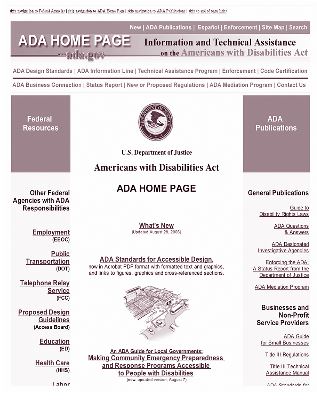
In fiscal year 2005, the Department added to the ADA Website Reaching Out to Customers with Disabilities, an interactive, online course that explains the ADA and how it applies to businesses.144 The course condenses hundreds of pages of regulations, technical guidance, and Department policy into a product that is easy to use and understand. The course is in an accessible format that can be used by people who are blind or have low vision.
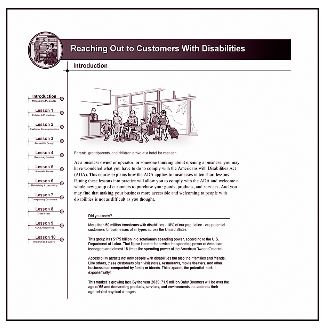
Using streaming video technology, the Department has also added three fully accessible streaming videos to the ADA Website in the past two years. Ten Small Business Mistakes145 features statements by store owners expressing their doubts or misunderstandings about the ADA followed by responses from Department officials and staff explaining the law in common sense terms. Police Response to People with Disabilities146 addresses law enforcement situations involving people who have mobility, speech, hearing, or vision disabilities, as well as people who have mental illnesses, mental retardation, or seizure disorders. The ADA Signing Ceremony147 documents the speech given by President George H. W. Bush when he signed the ADA into law on July 26, 1990. Copies of these videos can be ordered through the ADA Information Line or the ADA Website.
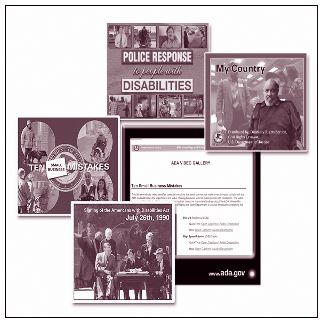
Videos available from the Department.
C. The ADA Business Connection
The ADA Business Connection is a multifaceted Department initiative that aims to improve access to everyday commerce by fostering dialogue and cooperation between the business community and the disability community. The ADA Business Connection has two main components: meetings and ongoing technical assistance for small businesses.
Since 2001, more than 640 participants from small and mid-sized businesses, large corporations, and organizations of people with disabilities have attended
16 dynamic ADA Business Connection Leadership meetings in cities across the United States. The sessions presented speakers from multinational companies, local businesses, and individuals with disabilities, who spoke about building business cases for accessible products and services, providing staff training, hiring employees with disabilities, and honing effective marketing techniques. These meetings have sparked lively and productive discussions, as well as promising collaborations between the business and disability communities. Some examples of the positive responses to the presentations include:
-
A three-way collaboration on accessible website design resulted from a meeting in Houston, Texas. A business technology consulting firm, a large technology corporation, and a disability technical assistance organization developed a design competition to encourage Houston businesses to create accessible websites.
-
One meeting participant, who serves as a senior vice president of a major hotel corporation, suggested to her company that its diversity advisory board include a representative of the disability community for the first time. She recommended a fellow ADA Business Connection meeting participant for that board position.
-
The hotel executive also responded to the session's content by requiring closed captioning on all new television commercials produced for her company and by recommending to a university's new hotel school that it include an instructional module on serving patrons with disabilities in its curriculum.
-
Upon leaving a Washington, D.C., meeting, a trade association vice president and the director of a disability organization began planning a joint effort to produce ADA compliance assistance materials for restaurant owners.
"The ADA Business Connection is a great thing. The meetings are important for maintaining connection to the issues and the people; the biggest value of the meeting is the communication."
- A business representative who attended a 2002 Business Connection meeting in Washington, D.C.
The ADA Business Connection has also produced a variety of compliance assistance materials addressing issues of specific interest to small businesses. Since 2001, the program has produced five ADA Business Briefs – short documents explaining specific ADA issues that are designed to be easily printed and distributed to employees. Topics addressed include service animals, restriping parking lots, providing assistance at gas stations, and effectively communicating in hotel and hospital settings with people who are deaf or hard of hearing.
The program also produced Expanding Your Market, a series of documents providing demographic and topical information specifically tailored to each of the meeting locations, identifying people with disabilities as a largely untapped market of customers and potential employees.
In addition, the program maintains the ADA Business Connection destination on the ADA Website.148 This web location houses the publications mentioned above, as well as Reaching Out to Customers with Disabilities, a fully accessible interactive online course that explains the ADA and how it applies to businesses in ten lessons. Also available on the ADA website is a streaming video of 10 Small Business Mistakes, a 13-minute video that identifies common mistakes that small businesses make when trying to comply with the ADA.149
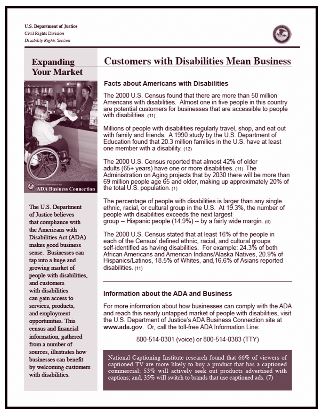
Footnotes
144 U.S. Dep't of Justice, Reaching Out to Customers With Disabilities, available at http://www.ada.gov/reachingout/intro1.htm.
145 U.S. Dep't of Justice, ADA Streaming Video Gallery, available at http://www.ada.gov/videogallery.htm.
146 Id.
147 Id.
148 U.S. Dep't of Justice, ADA Business Connection, available at http://www.ada.gov/business.htm.
149 U.S. Dep't of Justice, ADA Video Gallery, available at http://www.ada.gov/videogallery.htm.
VI. CERTIFYING STATE ACCESSIBILITY CODES
In order to truly realize the ADA's primary objective of enabling people with disabilities to participate fully in the business, civic, and social activities of their communities, we must eliminate the architectural, transportation, and communication barriers that limit or prevent such participation. The ADA specifically recognizes the importance of eliminating structural and architectural barriers by requiring all new or altered facilities subject to the ADA to be readily accessible to and usable by people with disabilities. Covered entities must comply with the Department's ADA regulations, including the ADA Standards for Accessible Design.
Facilities that must comply with the ADA Standards may also be required to comply with accessibility requirements established under state or local laws. There are thousands of jurisdictions in the United States that adopt or enforce building codes, some of which also include accessibility requirements. Although many state codes are based on national models, there can be significant variations among the state and local code requirements. Design and construction under state and local codes complies with the ADA only when the codes provide accessibility that equals or exceeds the ADA requirements. When these laws are inconsistent, the burden falls on building owners and design professionals to ensure compliance with both federal and state laws.
The enforcement of state codes is the responsibility of state or local officials – usually through plan reviews and building inspections. The ADA relies on the traditional method of civil rights enforcement through litigation in federal courts. Local officials do not have the authority to enforce the ADA on behalf of the federal government.
In an effort both to facilitate compliance with all applicable laws and to mitigate the tension between federal and state enforcement processes, the ADA authorizes the Department of Justice, upon request of state or local officials, to certify that state or local accessibility laws meet or exceed the requirements of the ADA.150 Certification bridges the gap between the federal and state enforcement processes. The certification process neither delegates ADA enforcement authority to the states nor eliminates an individual's right to seek relief through the federal courts. However, effective enforcement of a certified code can mitigate the need for federal enforcement by ensuring that new or altered buildings are accessible. This process gives building owners and design professionals some assurance in advance of construction that the ADA requirements will be satisfied. And, if a lawsuit is filed, compliance with a certified code may be offered as rebuttable evidence of compliance with the ADA.
Certification has other advantages. It facilitates compliance by transferring the burden of reconciling differences between applicable requirements from the covered entity to the Department of Justice and the responsible local building authority. It permits design professionals to rely on local compliance inspections and it ensures that accessibility will be routinely considered in those inspections. When compliance problems are identified, they can be corrected early in the construction process, at a time when mistakes can be corrected relatively easily and cost-effectively. By meshing local processes with federal requirements, certification makes accessibility part of the process, not an afterthought.
Since January 2001, the Department has certified the statewide accessibility codes of Maryland and North Carolina. Prior certification recipients included Washington, Texas, Maine, and Florida. The Department has provided detailed technical guidance to Indiana and California to assist them to make their codes equivalent to the ADA design standards. The Department has received and is reviewing certification requests from Utah and Washington (which has adopted a new code) as well as a technical assistance request from Michigan. A certification request from New Jersey is also under review.
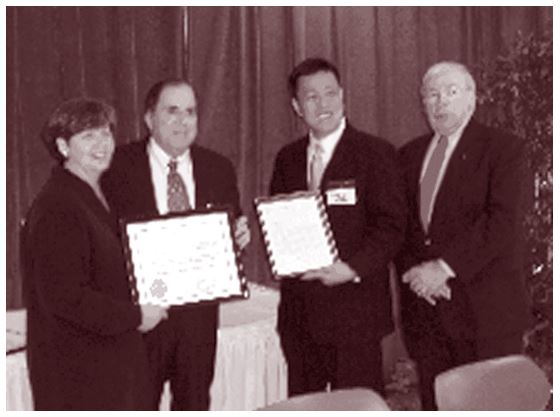
Assistant Attorney General Wan J. Kim presents an ADA Certification and a congratulatory letter to North Carolina Commissioner of Insurance James Long and staff members Laurel Wright and Jeffrey Kanner at February 9, 2006 ceremony in Cary, North Carolina, recognizing the ADA certification of the North Carolina Accessibility Code.
The Department has reached out to governors and state officials to encourage them to seek certification of their States' accessibility codes. Moreover, in tandem with the U.S. Access Board's efforts to encourage greater harmonization between model accessibility codes and federal accessibility guidelines, the Department has reached out to the private sector organizations that develop the model codes. In that regard, the Department is reviewing a request from the International Code Council, one of the largest model code organizations in the country, for technical guidance concerning the compatibility of its model accessibility code requirements with those of the ADA accessibility standards.
These certification efforts signal an era of cooperation, rather than adversity, between the Department of Justice, state and local code officials, and model code development organizations, working to eliminate barriers to the full participation of people with disabilities in the life of their communities. Together, we can ensure that the promise of the ADA is fulfilled while, at the same time, fostering creativity, utility, and cost-efficiency in building design and construction.
Footnote
150 43 U.S.C. § 12188.
APPENDIX: OTHER SOURCES OF INFORMATION
The Equal Employment Opportunity Commission offers publications and technical assistance to the public on the employment provisions of Title I of the ADA.
| ADA publications 800-669-3362(voice) 800-800-3302 (TTY) |
ADA questions 800-669-4000 (voice) 800-669-6820 (TTY) |
| Internet address www.eeoc.gov |
The Federal Communications Commission offers publications and technical assistance to the public on the communication provisions of Title IV of the ADA.
| ADA publications and questions 888-225-5322 (voice) 888-835-5322 (TTY) |
| Internet address www.fcc.gov/cgb/dro |
The U.S. Department of Transportation, Federal Transit Administration, offers publications and technical assistance on the transportation provisions of Title II and Title III of the ADA.
| ADA Assistance Line 888-446-4511 (voice/relay) |
| Internet address www.fta.dot.gov/ada |
| E-mail address ada.assistance@fta.dot.gov |
The U.S. Architectural and Transportation Barriers Compliance Board, or Access Board, offers publications and technical assistance to the public on the ADA Accessibility Guidelines.
| ADA publications and questions 800-872-2253 (voice) 800-993-2822 (TTY) |
| Internet address www.access-board.gov |
| E-mail address ta@access-board.gov |
The ADA and Information Technology Technical Assistance Centers are funded by the U.S. Department of Education, National Institute on Disability and Rehabilitation Research (NIDRR), in ten regions of the country to provide publications and technical assistance on the ADA.
| ADA publications and questions 800-949-4232 (voice/TTY) |
| Internet address www.adata.org |
Project ACTION is funded by the U.S. Department of Transportation to provide ADA information and publications on making transportation accessible.
| Information on accessible transportation 800-659-6428 (voice/relay) |
| Internet address http://projectaction.easterseals.com |
The Job Accommodation Network (JAN) is a free telephone consulting service funded by the U.S. Department of Labor, Office on Disability Employment Policy. It provides information and advice to employers and people with disabilities on reasonable accommodation in the workplace.
| Information on workplace accommodation 800-526-7234 (voice/TTY) |
| Internet address www.jan.wvu.edu |
How to File Complaints
Title I
Complaints about violations of Title I (employment) by units of State and local government or by private employers should be filed with the Equal Employment Opportunity Commission. Call 800-669-4000 (voice) or 800-669-6820 (TTY) to reach the field office in your area.
Titles II and III
Complaints about violations of Title II by units of State and local government or violations of Title III by public accommodations and commercial facilities should be filed with:
U.S. Department of Justice
Civil Rights Division
950 Pennsylvania Avenue, N.W.
DRS-NYA
Washington, D.C. 20530
If you wish the complaint to be resolved through the Department's ADA Mediation Program, please mark "Attention: Mediation" on the outside of the envelope.

User Comments/Questions
Add Comment/Question